December 31, 2003
Forbes 400 Best Managed Big Companies 2004
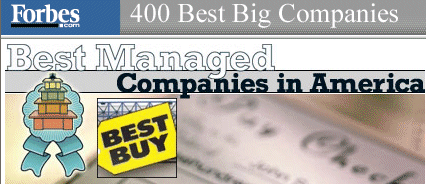
Since it’s New Year’s Eve and all, I decided to mooch off Forbes and supply the supreme list of companies to be admired – Best Buy tops the list this year and duly-so. Check ‘em all out for yourself.
Here’s hoping everyone had as blessed a 2003 as I did and I wish you a very Happy and Prosperous New Year in 2004.
- Arik
December 30, 2003
FedEx Acquiring Kinko’s to Compete with UPS and Mail Boxes Etc Stores
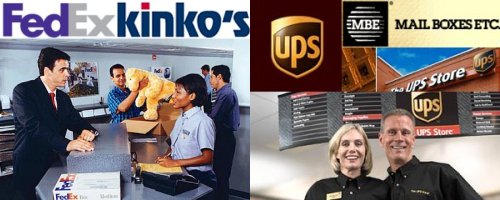
Just when you thought the holiday madness was over, FedEx announced today it’s paying $2.4 billion in cash to buy privately held business services provider Kinko's in a deal set to close in the first quarter of 2004. Of course, they’re a little late the party after the 2001 acquisition by top competitor UPS of Mail Boxes Etc. franchise operations, successfully rebranded as UPS Stores just this past April. But, it’s a step in the right direction, if FedEx hopes to keep a part of the retail interface to foot-traffic looking to ship from a local storefront. In the Motley Fool excerpt below, some of the logic (and competitive desperation) of the deal gets explained:
-
Soon, FedEx will offer its shipping options in 1,200 Kinko's stores (it currently has outlets in 134 Kinko's stores through a pre-existing agreement). The acquisition will help FedEx grab shipping business from the small- and medium-sized business market as well as from consumers who have fulfilled their other document needs in the stores.
Kinko's has been branching out from its humble beginnings as a copy center. It's no longer just about producing brochures, manuals, and business cards. Now, it offers its business customers some pretty fancy solutions in many of its locations, including Wi-Fi Internet hot spots and videoconferencing. For 2003, Kinko's expects to report $2 billion in revenues (though the acquisition won't add to FedEx's earnings until fiscal 2005).
With the high price tag comes the expanded retail presence and high-profile name brand that seems sure to usher in some built-in customers for FedEx. Over the last several years, the delivery company has suffered from a sluggish shipping business as the economy took a nosedive, and from heated competition from rival UPS and even the U.S. Postal Service.
Earlier this month, Fool LouAnn Lofton reported on FedEx's lackluster second quarter. A higher-than-expected number of employees jumped at the chance to take FedEx up on its early retirement package, resulting in a charge.
While the Kinko's acquisition might be a good idea, it's not original. In 2001, UPS bought Mail Boxes Etc. for about $185 million, a franchise that currently has 4,000 locations. With the possibility that UPS is indeed winning the market-share battle, one might wonder what took FedEx so long to tap into this market. However, by capitalizing on Kinko's well-known brand and non-franchise stores, the deal could deliver some excitement to FedEx shareholders.
What took so long indeed?! And why wait until after Christmas? Time to absorb and assimilate, I imagine. I looked back at what UPS had to say about the MBE deal, following April’s successful rebranding:
-
"The UPS Store is a significant step in UPS's strategy to strengthen its brand presence and expand access to our services for small businesses and individual consumers throughout the U.S.," said Rocky Romanella, vice president of UPS retail services. "The UPS Store extends competitive UPS pricing along with the outstanding customer service that has become synonymous with MBE franchisees over the past 20 years."
"This is an unrivaled combination of convenience, reliability and price," added Mathis. "We feel The UPS Store will transform the retail shipping industry."
"The franchising sector has never seen re-branding on this scale," said Don DeBolt, president of the International Franchise Association. "To see one of the world's largest companies working alongside a leading franchiser is historic on its own."
There are no plans to change the trade name of MBE's international locations. Currently, MBE has more than 1,000 units outside the U.S.
The UPS Store and Mail Boxes Etc. together comprise the world's largest franchise network of retail shipping, postal and business service centers, with more than 4,000 locations around the world. Mail Boxes Etc., Inc., a UPS company, franchises The UPS Store and MBE retail locations. In the United States, The UPS Store and MBE locations are independently owned and operated by licensed franchisees of Mail Boxes Etc., Inc. Outside the United States, locations are owned and operated by MBE master licensees or their franchisees.
So, what the UPS deal a better bet than FedEx’ Kinko’s move? It was certainly cheaper, even if they don’t have the asset base, due to the franchising model. This should be interesting to see who grows revenue more quickly… and retail outlets!
- Arik
December 29, 2003
Toilet Paper Wars: Charmin vs. Quilted Northern vs. Cottonelle
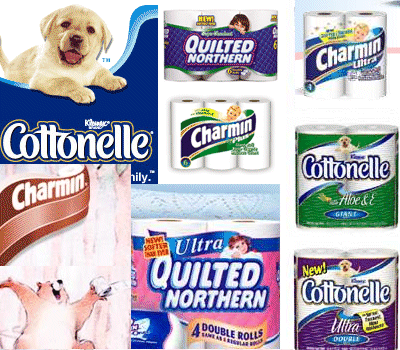
Going "head-to-head" (get it?) in the bathroom tissue business, we’ve got P&G versus Kimberly-Clark versus Georgia-Pacific in a new promotional war of international proportions, with P&G’s Charmin taking it up a notch. This isn’t Mr. Whipple’s TP business, as the New York Times excerpt that follows describes:
-
In the $4.7 billion business that is bathroom tissue, there is not a whole lot that separates one toilet paper from another. Since toilet paper is a commodity we all must buy - and do so, often without much brand loyalty - companies go to unusual lengths to get their messages across.
Procter & Gamble, to promote its Charmin brand, has begun showing up at state fairs to encourage people to use special "Charminized" rest rooms, which are not only clean but stocked with P.& G. products. Outside the restrooms, the Charmin bear dances and mugs to entertain the crowd.
And there's Georgia-Pacific, which this month weaved its Quilted Northern bathroom tissue into the regular programming of "The View," the morning gab fest on ABC.
Next up, on Jan. 5, Georgia-Pacific will introduce a $10 million campaign, created by DDB Worldwide in New York for Angel Soft tissue, including commercials introducing David and Larry, "bathroom angels" who perform such good deeds as restocking depleted toilet paper rolls. The company is the largest bathroom tissue marketer in the country, with a 38.9 percent volume share, according to Nielsen data provided by Georgia-Pacific.
But Quilted Northern - the company's biggest brand, with about a 21.5 percent share of the total market - still trails the category leader, Charmin, by about three percentage points. Cottonelle from Kimberly-Clark has about a 12.7 percent share.
The commonplace nature of toilet paper results in widespread discounting and promotional activity among manufacturers and retailers. That tends to erode brand image in a category where the last really notable advertising icon was Charmin's Mr. Whipple, who last appeared regularly in the 1980's.
"It's one of those categories where retailers will football on price, so it's been very difficult for true product benefits - making a better toilet paper - to translate into higher prices," said Paul Crnkovich, partner at Cannondale Associates, of Evanston, Ill. "The ultimate definition of brand equity is how much more you'll spend for Product A than Product B."
After P.& G. retired Mr. Whipple, the company spent years searching for an effective strategy that would differentiate Charmin. The company even brought Mr. Whipple out of retirement in 1999, but that did not last.
Several years ago, P.& G.'s longtime agency, D'Arcy Masius Benton & Bowles, turned to an animated bear to restore some pride to the Charmin franchise. (P.& G. last year moved the Charmin account to Publicis Worldwide, part of the Publicis Groupe.) The Charmin bear originally appeared in broadcast spots but has more recently been seen at state fairs and festivals, alongside the Potty Palooza, a 32-foot truck with 12 fully outfitted rest rooms, featuring hardwood floors, sinks, floral scents - and Charmin tissue, of course. P.& G. provides the truck as an alternative to portable latrines. While people line up to use the Potty Palooza, the Charmin bear dances and entertains the crowd.
In this case, the bear is extending the message of Charmin's broadcast commercials, in which he does the "Cha-cha-cha Charmin" dance.
"It gets people interested in the bath tissue category," a P.& G. spokeswoman, Celeste Kuta, said. "It's usually a low-involvement category." The bear, she added, "does it in a way you couldn't do with real people."
If Charmin's message remains playful, Quilted Northern opts for a somewhat more earnest approach, with the slogan, "It's Quilted Because We Care." A spot currently in rotation features a cartoon character named Wanda who doesn't care about quilting and, indeed, blows her nose into the quilt stitched together by the other characters, horrifying everyone. In the end, though, Wanda was just a nightmare conjured up by one of the quilters. DDB Worldwide, a New York agency that is part of the Omnicom Group, has the Quilted Northern account.
Kimberly-Clark's Cottonelle brand also stakes out a claim to caring in its marketing, via the slogan, "Looking Out for the Family." The company uses a Labrador retriever puppy to convey that small dogs, like families, need to be treated gently, a company spokesman said. J. Walter Thompson in New York, part of the WPP Group, has the Cottonelle account.
What can I say? Since I’m the grocery buyer in our house, I tend to get whatever’s cheaper and I don’t clip coupons, but that puppy is a lot cuter than the bear in my opinion… or Mr. Whipple.
- Arik
December 28, 2003
Green Bay Packers Keeping Playoff Hopes Alive
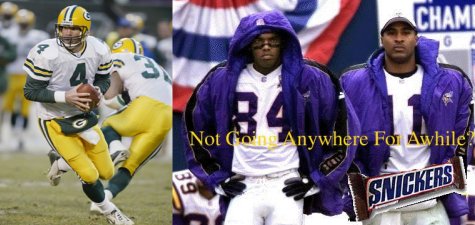
In what proved to be a pretty unlikely, but very exciting turn of events (assuming you’re a Packer fan… but then, who isn’t?), the Packers made the playoffs to represent for the NFC North! After a week in which quarterback Brett Favre’s father passed away, people are talking about their less-important win over the Broncos, while the Vikings lost a heartbreaker in Arizona, as if it’s Super Bowl destiny… but then, a lot of other teams will stand in Green Bay’s path on the way to Houston.
I found the perfect recap of the playoff weekend from none-other-than Boomer Esiason, posted on the Packers’ Web site, reminding us all that, not only did the Packers need to win, the Vikings needed to lose:
-
Watching the Vikings lose to the Cardinals Sunday wore me out - and I didn't even play. What a wild day for the NFL. Wasn't it Mike Holmgren who asked for divine intervention after his Seahawks beat the 49ers a day earlier? Well, guess what? The unexpected actually did happen. The Seahawks have Saints to thank; the Packers can thank the Cardinals.
There were smiles and cheers in Green Bay, while tears were shed in Minnesota. This season-ending loss to the Cardinals will be hard to forget for the Vikings' faithful and will be forever remembered in the annals of team history. If you watched the Vikings-Cardinals game from start to finish, you probably could never have predicted the outcome.
With a series of events that started to unfold last Monday night in Oakland, events too unbelievable to explain, it is now the Green Bay Packers who represent the NFC North in the playoffs. As the Packers were crushing the Broncos in Green Bay on the final day of the regular season, the lowly Cardinals were inflicting a final mighty blow to the Vikings in Arizona. What a way for Dave McGinnis to go out. With his career in Arizona finished, McGinnis is able to savor a memorable final victory over a heavy favorite that needed a win to make the playoffs.
What in the world was going on Sunday? It's hard to explain. My initial thought was that there's definitely a guardian angel flying over the Green Bay Packers and their quarterback, Brett Favre.
How else can we explain what happened in Arizona? These things just don't happen - a fourth-down, game-winning 24-yard touchdown pass on the game's final play by the Arizona Cardinals? Are you kidding me? Quickly, answer this: Who threw the pass and caught it? Answer: Josh McCown to Nate Poole. Now see if you remember that next year at this time.
As Vikings players fell to the ground in complete disbelief in Arizona, pandemonium erupted at Lambeau Field. News of the Cardinals' game-winning touchdown spread like wildfire through the stadium as Packers fans gripped their portable radios and watched the luxury box televisions to confirm what they had just heard. Packers players got the sense that something must have happened in Arizona, as they could not understand why their fans were cheering so loudly for the two-minute warning. Let the postseason party begin in Green Bay.
Uh-oh! Wait a minute! The final play is under review in Arizona. They're waiting in Green Bay for final word from Arizona ... and finally, the ruling stands: touchdown. I wonder how many people thought of Irvin Favre, Brett's father, at that moment. I know I did.
It has been an awfully tough week for Favre, except for maybe the football game Monday night against Oakland and the scrimmage against Denver on Sunday - at least that is how the Denver Broncos viewed the game against the Packers. It was what took place between these two games that tested Favre.
And, in fitting post-win gloating, a friend sent me the following poem:
The Last Week of Football
‘Twas the last week of football, and all through the game,
The Packers were winning, the Broncos were lame.
The Vikings were playing the Cards without care,
In hopes that the post-season soon would be there.
The NFC North they had all but wrapped up,
An eleven point lead should have been quite enough.
I still watched the Packers, but to my dismay,
What a shame that another game they would not play.
At the two-minute warning there arose such a chatter,
I quickly switched channels to see what was the matter.
From CBS to Fox, I used the remote,
And saw that game end on this wonderful note:
The Cards had just scored with two minutes to go,
It seemed that the lead, the Vikings might blow.
Then what to my wondering eyes might appear,
But a recovered on-side kick, one more thing to cheer.
The seconds ticked by as I started to wheeze,
The Vikings’ defense looked a lot like Swiss cheese.
And then on the very last play of the game,
Came a miracle touchdown, Lambeau Field was on flame!
You see, our own fans had now heard of that score,
As the shock did wear off, they started to roar.
It began to sink in as to what this did mean,
The Vikings had lost, eighteen – seventeen.
The coach who had blown a six-and-oh start,
Was whining and wailing and eating his chart.
When it became clear that he’d brought on more shame,
His thoughts turned to whom could he possibly blame?
Was it Culpepper, Kleinsasser, Hovan, or Moss?
Or was it McCombs, the team’s arrogant boss?
He looked at his list, and was checking it twice,
But the obvious choice was himself, Mike Tice.
So the Packers did clinch the NFC North,
And into the playoffs they would venture forth.
And Packer fans cheer with this holiday cry,
Happy Christmas to all, but to the Vikings Good-Bye!
Bravo! Now, they have to beat the Seahawks under their old (Super Bowl winning) coach Mike Holmgren… At least it’s at home in Title Town.
- Arik
December 27, 2003
Chinese Firms Buying Up Trademark Brands to Compete for Premium Prices

The move by Chinese firms to "go premium" and capture prestige brands and the awareness and loyalty they convey has long been a goal of a country most commonly thought of as the low-cost-producer, but recent moves by some firms to buy up everything from Dirt Devil to Revlon remind us of their rather more upscale aspirations. Here’s a few choice excerpts from the San Francisco Chronicle:
-
In 1905, in a backyard factory in Cleveland, workers began making vacuum cleaners for a company that became known as Royal Appliance Manufacturing Co. Almost a century later, Royal, which established the popular Dirt Devil brand, stopped making almost all of its vacuums in Cleveland because it realized it was cheaper to pay a Chinese company to do it.
Dirt Devil's departure would have been a relatively minor chapter in the grand exodus of American manufacturing to China. But this year the Chinese company that got the contract to make Royal's vacuums acquired something potentially even more valuable: It bought Royal and the Dirt Devil brand name, too.
Other Chinese manufacturing companies are also starting to buy the brand names of products that they formerly only produced. In some cases, they acquire the company, as with Nakamichi stereo gear, in others they get an exclusive licensing deal, as with Benetton eyeglass frames.
Hong Kong-based Techtronic Industries Co., the company that bought Royal and Dirt Devil, also grabbed the Ryobi tool brand from the parent company, Ryobi Ltd., in every market but Japan. As with Royal, Techtronic had been making Ryobi products for years. The Hong Kong company also bought two brands with products similar to ones Techtronic already made: the Homelite outdoor-products brand from Deere & Co. of Moline, Ill.; and the VAX brand of floor-care products, formerly owned by England's VAX International Ltd.
The purchase by Chinese manufacturing companies of Western and other foreign brands signals an important shift in the supply chain forged during the past three decades between the West and Asia. While such deals so far aren't numerous, conditions are ripe for many more, pointing to what may well be the next major phase in China's industrial evolution. Instead of constantly trying to lower their production costs to increase margins, Chinese companies are now trying to capture brand value - the ability to sell their products at a higher price directly to consumers who are willing to pay for a recognized label. If this trend continues, it means more dollars paid for brand-name products will wind up in China.
Several factors are responsible for the increasing Chinese purchases of American brands. Many U.S. companies - particularly those that own midsize brands such as Dirt Devil - have been under pressure as Asia's cheaper, no-brand goods flooded into the U.S. and competed directly with American brands. Major U.S. retail chains have played these weaker brands against each other, demanding bigger discounts, faster delivery and lower inventories.
In addition, Chinese factories themselves are feeling the trickle-down effect of this pressure. The country's rapid development has produced an oversupply of factories, forcing Chinese manufacturers to vie with one another to produce the same goods for the American and European markets. The intense competition has driven down prices and made their margins razor thin.
"We looked at our product lineup and we saw this trend of shrinking margins, greater competition," says Christopher Ho, chairman of Grande Holdings Ltd., a Hong Kong-listed consumer-electronics manufacturer, which supplied Sony, Pioneer, JVC and others.
Grande snapped up three Japanese electronics brands in bankruptcy proceedings. Its margins on those lines are between 8 percent and 10 percent, compared with 3 percent to 4 percent on the products it makes for others.
Similarly, Hong Kong firm Moulin International Holdings Ltd. in 2001 bought the licenses to a portfolio of brands including Benetton, Revlon and Sisley, from three European companies that were struggling.
In general, the Chinese companies acquiring foreign brands have been focused on making products, not marketing them. And managing brands sometimes puts them in unfamiliar territory, as they must respond to the changing tastes of consumers half a world away.
In the course of its brand-buying spree, Techtronic has increasingly moved away from its roots as a no-name, low-cost Chinese manufacturer and toward an integrated marketing and sales company. It deals every day with major U.S. retailers such as Home Depot Inc. and Wal-Mart Stores Inc. as well as European retailers. Since its first acquisition in 1999, Techtronic's revenue has risen more than threefold to $1.2 billion last year; profit has almost tripled in the same period, to $53 million.
At this stage, Techtronic maintains the same close relations with its Royal unit that it developed as a supplier. The U.S. subsidiary, based in Glenwillow, Ohio, still handles much of the marketing for the Dirt Devil brand, although Techtronic has begun working in that area, too. Hong Kong staffers are more involved with retailers and have taken a bigger role in dealing with product design and presentation.
There a fascinating history of Techtronic also included in the article, so I’d encourage you read the whole thing. And, keep watching Asia for brand migration. Odds are, we’ll see more U.S. dollars flowing that direction in the future, especially if Beijing successfully resists Washington’s pressure to let their currency float, even as the U.S. continues to devalue the greenback in hopes of making America more competitive abroad.
- Arik
December 26, 2003
Barbie vs. Bratz: Dolls Battle for Marketshare ‘Neath the Christmas Tree
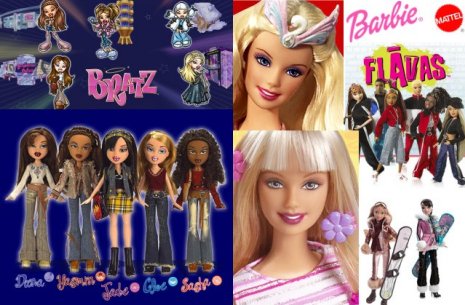
At one of my family Christmas get-togethers this holiday season, I noticed the presence of a new, funkier kind of doll for girls – the "Bratz" dolls and all their accompanying accoutrements. Intrigued, I did a bit of research and found out they’re taking a king-sized bite out of a market ordinarily served by an older forebear, Barbie. Here’s an excerpt from an article that sums up the phenomena:
-
For the first time in Ken Grow's 27 years as a toy retailer, Barbie lost ground to a rival fashion doll during the holiday season.
"The best doll this year . . . has been the Bratz doll," said Grow, owner of Gregory's Toys, an independent store in Encino. "Barbie has lost a lot of steam."
Mattel, the world's largest toy maker, is not accustomed to seeing its flagship fashion doll face such stiff competition. Its line of electronic learning toys also is faltering in what has become a tight market for toy producers.
"Those are two key categories for us," said Robert Eckert, chairman and chief executive of Mattel. "We had been gaining market share for the last several years, and in fact we lost market share in the first part of this year."
Sean McGowan, a toy industry analyst at Harris Nesbitt Gerard, estimated that Mattel's share of the fashion doll market has dropped from 75 percent to about 60 percent since 2000.
The toymaker has other problems. Along with increasing competition, Mattel has been weathering the fallout of 2002's dismal holiday season that led to a surplus of inventory and tighter spending by retailers. And it has seen its profit margins weaken amid pricing pressure from Wal-Mart and other discounters.
Eckert took over as CEO three years ago as Mattel struggled to overcome the ill-fated $3.5 billion acquisition of software maker Learning Co. As he focused on building the company's core brands like Barbie and Hot Wheels, Mattel stock bounced back and international sales increased.
But domestic sales lagged during the first three quarters of this year. "We did spend the first part of this year working off those inventories," Eckert said. "On top of that, our own product line was not doing particularly well in the first part of this year."
Through August, Bratz dolls topped the fashion doll market, according to the NPD Group, a marketing firm. The line produced by MGA Entertainment sports a sexy, urban look that embodies contemporary teen fashion.
"Right now, there's nothing but the Bratz dolls," said consumer Jennifer Joyce of La Crescenta, whose 10-year-old daughter used to collect Barbies but has moved on to Bratz.
Mattel has tried to keep Barbie edgy by marketing the My Scene Barbie, which sports a youthful, contemporary style, and the hip-hop-inspired Flava doll line.
Grow, the Encino toy-shop owner, said his customers haven't shown much interest in the My Scene dolls, which hit stores last year, or the Flava dolls, which debuted during the summer. Chain stores such as Wal-Mart and Target have discounted the dolls, trying to move them off the shelves.
In toys for boys, Mattel still leads the die-cast car market with its Hot Wheels and Matchbox brands. But some of its action figures haven't sold well, McGowan said.
Jill Krutick, an analyst with Citigroup Smith Barney, believes Mattel is well-positioned heading into 2004 because of ongoing product innovations.
The company is counting on a new race track called T-Wrecks that features a dinosaur that swallows and then spits out toy cars. To keep the interest of older kids who played with Barbies and Hot Wheels as children, Mattel has started marketing tie-in videos, clothing, cameras and electronic games.
Mattel's main competitor, Hasbro, has gained momentum in recent years with popular brands such as Transformers and Beyblade, a line of shooting toys.
In the past 12 months, Hasbro stock has gone from just under $12 to its current $21. Mattel's stock is hovering near $19 -- the same level it traded a year ago.
I found another couple of excerpts from BrandChannel.com, with a decidedly more positive opinion:
-
Mattel’s popular icon has weathered many political, cultural and social storms since her introduction in 1959, but in the end she remains a plastic doll with a cheery smile and a perfect figure, a woman many little girls admire even when they realize that Barbie’s proportions don’t match reality. Billed as "a shapely teenage fashion model," Barbie made her first appearance at the American Toy Fair in New York City and soon became a hit. Her abrupt departure from traditional baby-faced dolls, however, drew criticism that has never stopped even though the nature of the complaints has changed.
Mattel did its best to satisfy both the critics and fans of Barbie, reshaping her face early on to give her a softer look and even trying in recent years to make her body more closely match that of an average woman. The doll’s ubiquitous fashion accessories have also changed with the times, although Mattel made sure that there was nothing salacious about Barbie wearing a mini-skirt in the 60s or a tube top in the 80s, despite her popularity in a culture that has become increasingly open about sexuality.
The company also began rolling out Barbie’s supporting cast in the early 60s, starting with Ken. (Mattel should abandon attempts to quell rumors that Ken is gay and Barbie is really in love with G.I. Joe; the speculation helps keep the brand in the public’s mind.) Barbie’s best friend Midge and her little sister Skipper followed soon after, and the subsequent 30-plus years have seen the addition of a black doll named Christie, an "artsy bohemian" named Chelsea, and others.
Mattel’s response to feminists include Astronaut Barbie and Doctor Barbie, which debuted in 1986 and 1988, respectively. Day to Night Barbie (1985) reflected the yuppie lifestyle of the 80s, complete with an executive’s outfit for Barbie’s 9-to-5 office job and evening wear for a night on the town. She even came with a small calculator, perfect for crunching the numbers needed for financial reports.
In 1992, the Barbie Liberation Organization became upset when a Talking Barbie included the phrase "Math class is tough." The group switched her mechanisms with G.I. Joe’s, creating homemade Barbies that yelled "Vengeance is mine!" While the incident was amusing, and it did successfully spread the group’s message, it did little to harm the brand. In fact, Mattel’s strategy in this area is to ignore the critics, as many of them will be unhappy with the doll no matter what the company does. If a mother is truly unhappy with the image Barbie projects, there’s little Mattel can do that it hasn’t done already.
But while the critics have done little damage to the brand, competitors continue to search for ways to cut into Barbie’s market and mind-share. From cheap knock-offs sold in dollar stores to upstarts like MGA Entertainment’s Bratz, which tries to cash in on current American youth culture with a brash image, Barbie faces many threats within the market niche. In response, Mattel created the "My Scene" line, which features similar fashions without the "in your face" attitude.
Brand consultancy Interbrand ranked Barbie 97th with a value of US$ 1.87 billion, down three percent from the year before, in its 2003 Best Global Brands report with BusinessWeek. While a loss of brand worth is never good, Mattel doesn’t need to panic. It has spent more than three decades building a brand that includes not only toys but also videogames, board games, comic books, cartoons, and other spin-offs that constantly keep Barbie in the public eye.
So, good luck Barbie – this battle with the Bratz is one fight where it looks as if you’ll need all the luck you can get.
- Arik
December 25, 2003
U.S. Mad Cow Discovery Promises to Rein-In Recent Gains for the Beef Industry
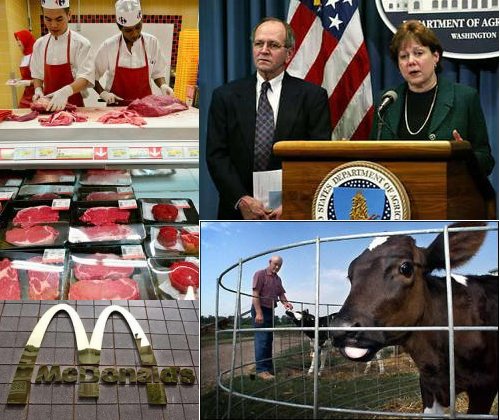
This isn’t very Christmas-y but it’s sure to affect a few different players in the food business, so here goes…
The first case of mad cow disease in the U.S., revealed on 23 December 2003, is likely to have a devastating impact on U.S. cattle and beef prices and could pummel the shares of companies like meat packer Tyson Foods and hamburger chain McDonald's.
The disease warning signs showed up when the infected dairy cow was sent to slaughter on 9 December. Inspectors described the cow as a "downer" before it was killed, meaning that it was unable to move on its own. Officials wouldn't comment on exactly why the animal wasn't mobile, but experts say there could be any number of reasons, including old age, injuries or disease.
By law, inspectors at slaughterhouses are supposed to reject cattle that have trouble walking and rule cows with supposed brain disorders unfit for human consumption. Sick cows are then be sent to a rendering plant, which is what appears to have happened here. Apparently, scientists took samples of the infected cow's tissue, to test for disease, while its brain and spinal cord, described as the "infectious" parts by Ag Secretary Ann Veneman, were sent on to be turned into protein feed and oil. As a result, "we believe the risk to human health is very low," Veneman said. As for the other animals that'll eat the protein feed, who knows?
Thanks to the Atkins Diet, beef prices have risen to where producers are finally able to turn a decent buck. All good things must come to an end, eh? For hamburger chains the concern is whether consumers will cut back on eating beef – a consumer backlash hurt McDonald's sales in both Europe and Japan after they reported mad cow cases in recent years.
Then 24 December, Japan, the world’s top importer of U.S. beef, blocked imports and imposed an indefinite ban on U.S. and recalled other meat products already on the market. South Korea suspended inspections of U.S. beef, and suspended sales of meat already on supermarket shelves. Hong Kong, Australia, Taiwan, Singapore, Thailand and Malaysia followed suit. Russia also issued a temporary ban, while in Brussels, the European Union, which already bans much U.S. beef because of fears about growth hormones, said it would not take any additional measures against U.S. beef.
So really, how big a deal is this for the U.S. beef industry? Here’s an excerpt on the impact from AP:
-
Antonia Mochan, a spokeswoman at the EU's executive Commission, said the United States was already classified as an "at-risk country" as part of the sweeping EU measures adopted following Britain's mad cow crisis, which began in the late 1980s and spread across western Europe. Under those restrictions, imports of specific risk products, such as brains, are banned.
The moves came after the U.S. government announced that a Holstein cow on a Washington state farm tested positive for mad cow disease, marking the disease's first suspected appearance in the United States.
British experts said the United States must seek out the help of countries that have experience dealing with the disease and must take swift action to restore consumer confidence in its beef stocks.
"The key here is to restore confidence quickly, not to allow it to drag out," Sean Ricard, former chief economist of Britain's National Farmers' Union, told British Broadcasting Corp. radio. "What I hope America will do is take rapid action, perhaps slaughter the herd that animal came from."
Ricard predicted a short-term slide in the price of beef in the United States.
U.S. Agriculture Secretary Ann Veneman said the risk to human health in this U.S. case was "extremely low." Parts of the cow that would be infected - the brain, the spinal cord and the lower part of the small intestine - were removed before the animal went to a meat processing plant.
The immediate reaction also reflected the widespread consumption of U.S. beef in Asia, where American eating habits have gained tremendous popularity in recent decades, as evidenced by the proliferation of fast-food outlets.
Australia - a major beef exporter that stands to gain economically from a bans on U.S. imports - placed a temporary hold on American beef, Agriculture Minister Warren Truss said Wednesday.
In Canada, where a single case of the disease was found in May, federal officials said late Tuesday that imports wouldn't be banned unless the suspected case was confirmed.
Japan's Agriculture Ministry said its ban applied to beef and beef products and took effect immediately.
"We must ban beef imports from the United States for the time being," said Health Minister Chikara Sakaguchi. "We must recall products that include so-called 'dangerous parts,'" such as brains and spinal cords.
Japan is the largest overseas market in value terms for U.S. beef. Exports totaled $842 million in 2002, accounting for 32 percent of the market for U.S. exports, according to the U.S. Meat Export Federation. South Korea is No. 2 in value, with $610 million. Mexico, the top importer of U.S. beef in volume terms, was third in value in 2002, a federation official in Seoul said.
Japanese authorities have been especially leery about mad cow disease since the nation's herds suffered the first recorded outbreak of the disease in Asia in September 2001, causing meat consumption to plunge. Consumption, however, has since rebounded.
While fresh imports to Japan have been banned, there was no widespread rush to pull American beef from supermarket shelves. A spokesman at Ito-Yokado, Japan's largest supermarket chain, said the retailer had faith in the safety of the beef already on its shelves and would sell its stocks.
The Aeon chain, however, said it was going to pull American beef from its shelves.
Ito-Yokado imports its U.S. beef from herds in the midwest, far from where the infected Holstein was discovered in Washington state, the spokesman said, speaking on condition of anonymity.
The United States supplied 46.5 percent of Japan's beef imports in 2002, or 226,524 tons, second only to Australia. There was speculation in Japan that the ban would cause major bottlenecks for restaurants as they scrambled to find other suppliers.
The mad cow scare already took a toll on restaurant stocks in Japan. Shares of Yoshinoya, a "gyu-don" meat and rice restaurant chain where 99 percent of the beef is American, plunged 9.4 percent, and stocks of McDonald's Japan, which said it exclusively serves Australian beef, lost 3.1 percent.
In Hong Kong, the territory's government said in a statement that the temporary ban is a precaution, saying "there is no evidence to suggest that U.S. beef on the market is unsafe."
In Singapore, the Agri-Food and Veterinary Authority said that if the mad cow disease case is confirmed in the United States, the country will not import American beef again until Washington certifies that it has been free of the disease for six years.
Taiwan said U.S. beef could face a seven-year export ban.
Mad cow disease, known also as bovine spongiform encephalopathy, eats holes in the brains of cattle. It sprang up in Britain in 1986 and spread through countries in Europe and Asia, prompting massive destruction of herds and decimating the European beef industry.
People can contract a form of mad cow disease if they eat infected beef or nerve tissue, and possibly through blood transfusions. The human form of mad cow disease so far has killed 143 people in Britain and 10 elsewhere, none in the United States.
Secretary Veneman mentioned she's serving beef at her place Christmas Day... but this makes me want to reconsider vegetarianism.
Merry Christmas Everyone,
- Arik
December 24, 2003
Christmas Toy Wars

As Christmas Eve dawns, we see the end of the Toy Wars that have eroded a lot of the profit out of being in the toy business. Wal-Mart's price war has impacted toy-specific retailers the most - KB and Toys-R-Us - but KMart, Target and others are also feeling the heat.
Here's an excerpt from the San Diego Daily Transcript, that I think offers a good summary macro-view of take-aways similar to many local toy markets across the country:
-
FAO Schwarz's Zany Brainy children's toy stores are liquidating in what could be the beginning of meltdown in the toy industry. Zany Brainy, scheduled to have closed all its stores by the end of January, has numerous locations in San Diego, including a store in Fashion Valley, on Westview Parkway in Mira Mesa, and on Grossmont Center Drive.
FAO Schwarz, a toy retailer in danger of going out of existence, also once had a store in Horton Plaza. FAO Inc., the toy retailer's parent, filed for Chapter 11 bankruptcy for the second time in a year earlier this month.
On Nov. 17, as noted by Bloomberg News, New Jersey-based Toys "R" Us Inc., the second-largest U.S. toy retailer behind Wal-Mart, announced it would close 182 Kids "R" Us and Imaginarium stores.
Toys "R" Us closed its Imaginarium store in Horton Plaza after an unsuccessful run some years ago. A Kids "R" Us store that exists in La Mesa will be closed. While there are only a couple of Toys "R" Us-related stores that have or are scheduled to close in San Diego County, a look at the company's bottom line suggests that more closures could be on the way.
Toys "R" Us store locations in San Diego County include stores at 8181 Mira Mesa Blvd. in Mira Mesa; 1240 Morena Blvd. in Linda Vista; 1100 East 30th St. in National City; 1240 Auto Parkway South in Escondido; 2425 Vista Way in Oceanside; and 1008 A Industrial Blvd. in Chula Vista.
Toys "R" Us reported a net loss of $38 million, or 18 cents a share, in the quarter ended Nov. 1 compared to a net loss of $28 million, or 13 cents, for the like quarter a year earlier.
The Wayne, N.J.-based company had announced late last year it would be slashing 1,900 jobs and closing 64 stores as it continues a restructuring effort to focus on its core toy business, but the company hasn't been able to stop the bleeding. Pretax costs for the store closings are estimated to be about $280 million.
Toys "R" Us, like FAO Schwarz, is trying to keep Wal-Mart at bay. As noted by Bloomberg News, sales at Kids "R" Us stores opened at least a year dropped 11 percent, for the fifth straight decline.
A check of online prices at both Wal-Mart and Toy "R" Us revealed that the Swan Lake Beauty Castle that cost $109.99 at Toys "R" Us, cost just $98.97 at Wal-Mart.
Toys "R" Us is offering as much as 40 percent off merchandise such as Hot Wheels cars, but analysts wonder whether it will be enough.
"I can't really get comfortable about (Toys "R" Us) long-term competitive position," said Abhay Deshpande, a retail analyst at First Eagle Funds, whose $11 billion in assets don't include Toys "R" Us shares. Deshpande, who had personally owned the retailer's shares, dumped the Toys "R" Us portfolio in 2001.
While conceding it may not be able to compete with Wal-Mart on price, Toys "R" Us is hoping that specialized customer services, such as providing play areas with everything from play pens to jungle gyms, will help it regain its market share. "We have done a complete overhaul of all of our stores," said Toys "R" Us spokeswoman Susan McLaughlin. "They are brighter, cleaner and a lot more fun."
Karen Burk, a Wal-Mart spokeswoman, said the most popular items this year are the Barbie Swan Lake, Teenage Mutant Ninja Turtles and Leap Pad books.
Sometimes, the toys are a result of a partnership with another retailer. In a joint venture with Home Depot, Toys "R" Us is offering a toy animal collection known as "Barnyard in a Bag." Then there is "Go-Go, the Walking Puppy," a robotic dog for $35, that normally retails for $49.99.
Stores such as Toys "R" Us and KB Toy & Hobby of Massachusetts may have a difficult time competing head to head with Wal-Mart, because they carry many of the same items. There are four Geppetto stores in Fashion Valley, La Jolla, Bazaar del Mundo and at the Hotel del Coronado, and owner Brian Miller said the stores are doing fine.
"We're actually running a double digit increase, though I know that it's definitely not the trend," Miller said. Miller said there was what he referred to as "a bit of a shakeup in the toy industry," he responded with a blitz of newspaper and television advertising. The ads have paid off. "And we weren't afraid to buy inventory, so we're well stocked," Miller said. While admitting there are items that are sold in both stores, Miller said that Wal-Mart doesn't have the hand made items, nor the customer service.
Jules Martin, owner of Hobby Central, whose business is in the same shopping center as a Wal-Mart in Poway, said while there are a few things such as rocket motors that people might be able to get cheaper at Wal-Mart, they are not likely to find a person to give them chapter and verse about model rocketry.
There were a few other trend-pieces that I thought would make for good reading this holiday season:
- KB Toys Delays Payment to Some Suppliers
- Toy Giant FAO May Have Buyer in the Wings
- Fashion Dolls Fight It Out Between Wholesome and Trashy
- Knock-offs for the Toy Box?
Have a blessed holiday,
- Arik
December 23, 2003
Gift Cards & the Changing Face of Retail Revenues
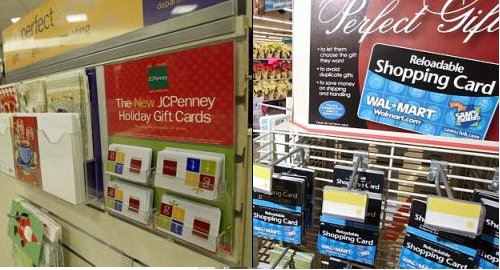
Gift cards are taking over 8 percent of holiday retail sales this year, and the stuff they’ll be spent on will most likely be higher-margin, splurge goods. The trends affecting retail revenue are shifting profoundly past New Year’s, as shoppers play chicken with retailers hoping for inventory reduction sales after Christmas, and post-holiday merchandising becomes more important as gift-carded consumers return to stores feeling flush with cash that needs to be spent – and those dollars will be spent on products they’d be less likely to buy for themselves if it was their own money being spent.
I found a few excerpts describing the trend much better than I from various sources below:
-
Retailers - like consumers - are hooked on gift cards, despite their potential to mess up earnings.
Perhaps no retailer knows that better than Wal-Mart, where heavy demand for holiday gift cards is slamming December sales, currently hovering at the low end of its 3% to 5% growth forecast.
The problem: Strong gains in gift-card sales can threaten the bottom line if consumers delay redeeming them. That's because gift-card purchases can't immediately be counted as sales. The purchase is logged as a liability until the card is swapped for merchandise.
So, to benefit the 2003 sales year, most retailers are depending on millions of holiday gift-card recipients to spend by the time their fiscal year ends Jan. 31.
Still, retailers say that gift cards foster customer loyalty, help win new customers and often coax consumers into spending more than the value on the card. They are so popular this holiday shopping season that sales are expected to hit $17.2 billion, or 8% of all sales, according to the National Retail Federation.
"There is only a 5% incidence where someone doesn't redeem a gift card within the first 30 days of receiving it, and that gap has been closing over the years," says Mike Brewer of Stored Value Systems, which processes gift-card transactions.
Still, retailers that wrap up the year in December have a greater urgency for gift-card redemption.
Major retailers closing books in December:
- Sears: The department store operator sells 20% to 30% of gift cards during the holiday season and redeems a "significant" amount shortly after Christmas. "We look at it as a great way to merchandise our brand. It's a way to give someone everything from tires to ties to dressers to dresses," says Bill Kiss, general manager of Sears Promotions. Sears eliminated expiration dates on gift cards Dec. 17. Previously, its gift cards expired two years from the date of purchase.
- Office Depot: The office products retailer sells about 60% of holiday gift cards during the last two weeks of the season, and value amounts this year are "double" last year's sales.
- A.C. Moore Arts & Crafts: The chain sells a "substantial" amount of gift cards during the holiday but isn't bothered by redemption after Dec. 31. "The rationale for gift cards is customer loyalty," says CFO Les Gordon.
Gift-card redemption rates are highest Dec. 26 and soon after while many consumers still have a few days off work and continue to hunt bargains.
The seven family members and co-workers for whom Chinissa Sumpter bought gift cards may be among them. "They give the recipient an opportunity to buy what they want," says Sumpter of Detroit, who spent $40 on each.
Talbots expects gift-certificate holders at the kickoff of its semiannual sale Dec. 26. "About one-third of gift certificates sold during the year are redeemed between Christmas through January," says Ed Larsen, CFO at Talbots.
Retailers don't benefit when cards aren't redeemed. Regulations, called escheat laws, vary from state to state. Some call for retailers to give any remaining balance or abandoned amounts to the state as unclaimed property after a lapse of time, according to Pillsbury Winthrop, a law firm specializing in laws relating to gift cards.
But most major retailers avoid the rule by eliminating expiration dates on cards or giving the unused portion back to customers as a store credit or, sometimes, cash.
Still, frustration abounds over restrictive policies some retailers have in place causing many consumers to give up the gift concept already:
-
Like more and more holiday shoppers, Juliette Coulter of Dallas thinks the right gift for many friends and family members is plastic and fits in a wallet. She's spending $300 in all this season on gift cards from Target, Old Navy, Starbucks and other stores. It means no worrying, for example, about size or style for a pair of nephews age 9 and 14. "They have very specific tastes, and I don't want to get them the wrong thing," she said. "I want them to think I'm the cool aunt."
Gift cards are hotter than ever this season, with merchants expected to sell more than $17 billion worth during the holidays, or 8 percent of all business, according to the National Retail Federation.. It actually helps them extend the selling season, as shoppers flood the stores after the holidays to redeem their cards and, the stores hope, spend a little more.
Yet as the cards become more familiar, many recipients are grumbling about some headaches associated with them - fees that can erode their value if they are not used quickly, problems getting replacements if they are stolen or lost, what to do with that last few dollars or even cents of credit.
Aware of the issues, and fearful of losing what has become a key piece of business, some store chains are revising their policies or doing more to educate customers about how to get the most out of gift cards.
Coulter said she doesn't worry about card fees as her recipients use them quickly - which is often the only way to make sure you get full value. Dennis Fish, of Atlanta, learned that the hard way.
Fish purchased a $120 gift certificate from a spa for himself and his wife last year. They waited just over a year to use it - and were hit with a 20 percent "reactivation" charge. The card had a one-year expiration period.
"Never will I buy one again until I know the ins and outs of the policies," he said.
He complained, and got the charge lifted. But he's buying just two cards this year, compared to 10 last year.
Brad Ferris of Washington said the cards "drive me nuts."
"If you get a $300 card and you only purchase $250, you end up forking out more money to these stores because they don't refund the cash you don't spend," he said. "I always receive these cards, and they end up being more of an expense than a gift."
Besides reactiviation fees, some store cards carry a kind of reverse-interest that's charged over time. Bank-issued cards often have an initial charge.
"Consumers are going to find out that their gift cards are not worth as much as they thought they were worth," said Gail Hillebrand, senior attorney at consumer advocacy group Consumers Union of U.S.
Her group supported legislation passed in California eliminating virtually all gift card and gift certificate fees effective January 2004. That state already has a law that keep cards from having expiration dates. In New Hampshire, cards that have a $99 value or less can be used anytime, while in Massachusetts, any gift card is now valid for up to 7 years.
Retailers say reactivation and other fees help cover costs to maintain the systems that track card credits, and are fair because the costs thus are charged only to consumers who delay in using them. There can be accounting costs, since stores don't record gift card sales on their final books until the cards are redeemed, according to the National Retail Federation.
But they are sensitive to the growing chorus of complaints. Several major chains, including Sears, Roebuck and Co., Barnes & Noble Inc. and J.C. Penney Co. Inc. have eliminated fees in time for the holiday season. Back in February, 18 national retailers - including Bloomingdale's, Toys "R" Us and Target Corp. - agreed to replace customers' lost, stolen or damaged gift cards.
Still, there are plenty of companies that have charges or have some sort of restrictions. A sampling:
- Wal-Mart Stores Inc. charges $1 fee per month after 24 consecutive months of inactivity.
- Barnes & Noble Inc. will replace damaged cards, but not stolen or lost cards. In October, the retailer eliminated its $1.50 monthly fee that it charged after 12 months of inactivity.
- American Express's prepaid card charges $2 a month after 12 consecutive months of nonuse. There's a $3.95 initial fee, if purchased online at americanexpress.com, or a $7.95 charge - if purchased by phone. When purchased in person, fees vary from $3.95 to $9.95.
- Simon Properties-Visa gift card program - which is expected to be Visa's largest gift card program this year, has an initial fee of $1.50, and has a service fee of $2.50 per month beginning with the seventh month. The initial fee is still low compared to Visa's other members, which can go as high as $7.
Lucy Lazarony, a researcher at Bankrate.com, recently studied the gift card policies of major banks and retailers. For gift cards ordered online, she said, Lazarony many retailers charge a shipping and handling fee ranging from $1.95 to $8.95 for standard shipping.
Visa USA said that consumers are seeing the value of their gift cards because it has "universal acceptance" - they can be purchased at any store that accepts Visa - and they can be replaced if stolen or lost. But company officials acknowledge that consumers could use more education about the policies.
"We are working with our members to adequately overdislose information" to consumers, Kenny Thomas, a company spokesman. That includes spelling out policies right on the back of the card.
Still, the cards' popularity is expected to keep growing. C. Britt Beemer, chairman of America's Research Group, based in Charleston, S.C., said gift cards have become the "grand slam" of the 2003 holiday season.
According to Bain & Co., card sales for 2003 will total anywhere between $42 billion to $45 billion in sales this year, up from $36 billion to $38 billion in 2002. Exact figures are hard to determine.
Stores like gift cards because they cut down on returns - and about two-thirds of recipients spend more than the value of the cards, according to Rob Markey, a director at Bain.
They also increase sales of regular-price items, because shoppers using a card are less interested in getting a discount.
Michael Brown, a retail operations specialist at Kurt Salmon Associates, estimated that about 10 to 15 percent of the value of the cards are never used.
Hillebrand, at Consumers Union, knows how gift-givers can prevent that from happening.
"Write a check," she advised.
Here, here.
- Arik
December 22, 2003
Parker Brothers & the Monopoly® Monopoly
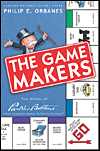 Having been an undergraduate history major, as well as someone interested in business and competition, I recently found an excerpt from a new business history on Parker Brothers, the board game company, on Harvard B-School’s "Working Knowledge" site. Even if you’re not buying board games for the family this Christmas, it’s a pretty interesting story:
Having been an undergraduate history major, as well as someone interested in business and competition, I recently found an excerpt from a new business history on Parker Brothers, the board game company, on Harvard B-School’s "Working Knowledge" site. Even if you’re not buying board games for the family this Christmas, it’s a pretty interesting story:
-
In 1883, George Parker was 16 years old, and he liked to play board games. But he and his friends were tired of the "heavy-handed moral lessons" of the typical board game, and George, an inventive young man, created his own game, called Banking (chartered banks were a relatively new thing in the U.S., and people were fascinated by the whole subject). It was a success, and soon George and his brother, Charles, formed their own company, Parker Brothers.
The Monopoly game, Trivial Pursuit, Clue, Boggle, and Risk are more than just games to us - they're part of America. All of these games were published by one company, Parker Brothers, which began as the dream of a sixteen-year-old boy, over one hundred years ago.
In "The Game Makers", industry expert Phil Orbanes reveals how, by adhering to the principles of its founder, Parker Brothers rose to prominence, overcame obstacles, and forged lasting success. Orbanes, a game historian and former executive at Parker Brothers, draws from company archives, interviews with surviving family members, and the newly discovered records of founder George Parker to tell a story rich in examples of business acumen that spans world wars, family tragedy, the Great Depression, and global competition.
That said, I also found a critique of George Parker’s claim to fame, called "The Billion Dollar Monopoly Swindle", which claims Parker wasn’t so original after all and should take his place among his turn-of-the-century-robber-baron-peers:
-
Part detective novel, part history, and part horror story, The Billion Dollar Monopoly® Swindle not only recounts the true history behind one of the world's most popular board games but also reveals a world where the law sometimes seems as arbitrary and unfair as a "Go directly to jail" card. When Ralph Anspach released his game Anti-Monopoly in 1973, he suddenly found himself in the crosshairs of the formidable Parker Brothers legal machine, which claimed that his use of the word monopoly violated copyright laws. While conducting research to gauge the strength of Parker Brothers' case, Anspach discovered that the corporate giant might not even have the rights to the game.
His investigation revealed the existence of a board game called the Landlord's Game that had been played at least 30 years before Parker Brothers published Monopoly in 1935. When Charles B. Darrow was introduced to this game by a group of Quakers, he copied their board and rules verbatim (even duplicating their misspelling of "Marvin Gardens"), then sold it as his own creation. Parker Brothers supported him, putting a copy of the "story of Monopoly" that cited him as creator in every box.
As for the Anti-Monopoly case, Anspach faced down the game moguls in a battle that went all the way to the Supreme Court (and included an unexpected appearance by future independent counsel Kenneth Starr). You can still play Anti-Monopoly today - and Anspach has even started packaging the original version in the game boxes as a bonus.
Sounds a little like revenge to me - Anspach's attempts to poke PB after getting waxed in court. Still, it's interesting how even a game company knows how to protect its competitive interests.
- Arik
December 21, 2003
New York’s Planned "Freedom Tower" Unveiled Amid Uncertainties Over Tallest Building Designation

This week’s unveiling of the 1,776-foot-tall "Freedom Tower" called into question the designation process for whether the proposed tower really will be the world's tallest, assuming it’s ever built. Despite repeated claims yesterday that it would be, the New York Times speculates the organization that bestows that honor might not think the latticework wind farm on top counts as part of a "habitable building." That’s got a few people annoyed: "The world's tallest building moniker is a shibboleth of feel-good boosterism perpetrated by rebuilding officials who have nothing else to offer the public but a P.R. campaign."
-
New York officials Friday unveiled final plans for the Freedom Tower, a shimmering skyscraper of glass, cable and steel rising over the World Trade Center site that will be the world's tallest building.
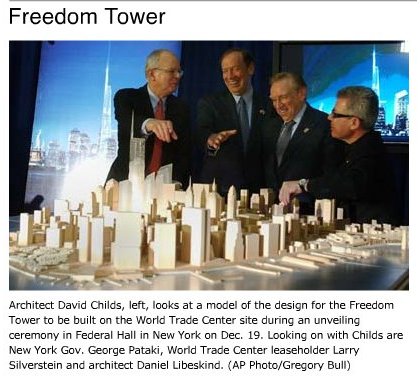
Gov. George E. Pataki hailed the sleek, twisting structure - whose angular, upward slope echoes the Statue of Liberty - as "a major step forward in the rebuilding of New York" after the Sept. 11, 2001, terrorist attack. He also praised the blueprint as a "stirring collaboration" between two prestigious architects who, until recently, had been feuding over their roles in the project.
Plans for the new commercial building were revealed during a brief ceremony at Federal Hall in Lower Manhattan, where George Washington was first sworn in as president and where the first U.S. Congress met. Officials repeatedly invoked the symbolism of the building, noting that the Freedom Tower would soar 1,776 feet into the air.
The building, which will sit at the northwest corner of the 16-acre World Trade Center site, will "dramatically reclaim a part of the New York skyline that we all lost on 9/11," Mayor Michael R. Bloomberg said. He suggested that the five-building complex planned for the site could be completed in 10 years.
Although officials selected a plan in February to develop the site, it has since undergone some crucial modifications - most notably the construction of a glass-and-concrete addition above the tower's commercial floors. The winning design for a memorial to victims of the terrorist attack will be announced separately next month.
Architects Daniel Libeskind and David M. Childs, who designed the Freedom Tower, described it Friday as an expression of public art that, like the memorial to be built at Ground Zero, would send a message about American freedom to future generations. The crucial element, they said, was building something that would stand the test of time.
"To join the vision of this structure to the image of the Statue of Liberty is quite a statement," said Libeskind, who as a child of immigrant parents sailed into New York Harbor years ago. "This building will rise to the height of 1,776 feet and it must never be surpassed, because that number truly means something to us all."
But developer Larry Silverstein - who holds a lease to operate the World Trade Center - said the thing that mattered most to him was that the Freedom Tower work economically, spurring development throughout Lower Manhattan.
He voiced confidence that the new building would lure a multitude of tenants back to the area, and said he had promised Pataki that the cornerstone for the Freedom Tower would be laid next year before the third anniversary of the attack.
"What we see here today is beautiful and spectacular, something to be very proud of," Silverstein said. "But I am happy to say that it is also very practical."
Silverstein, who previously had expressed unhappiness with what he called commercially unrealistic plans to redevelop the site, said the Freedom Tower's safety measures would vastly outpace those of the original twin towers and would include better-protected stairwells, blast-resistant glaze on lobby glass and better interior alarm systems.
The design calls for 70 commercial stories with 2.6 million square feet of office space, plus an underground regional transit hub, garages and several retail shopping centers. There also will be a public observation deck and a rebuilt Windows on the World, the restaurant that once sat atop the north tower. In the attack on the World Trade Center, 11 million square feet of office space was lost.
Although the previous World Trade Center buildings each had 110 stories, the Freedom Tower will rise higher because of a large glass structure and 276-foot spire topping off the building. Childs noted that special wind turbines would be constructed, allowing the building to generate 20% of its own energy needs.
The upbeat mood of Friday's unveiling belied months of behind-the-scenes disputes, both artistic and political.
Although Libeskind's master plan was selected this year to guide overall development of the site, Silverstein and others brought in Childs, a consulting design partner at Skidmore, Owings & Merrill, to help sharpen Libeskind's blueprint and turn his vision into a concrete plan.
The two architects reportedly clashed during recent months over issues involving the building's height and overall design, causing Libeskind to complain that he had been pressured into a "forced marriage." Pataki, who was determined to meet a December deadline for the unveiling, brokered a compromise that retained key elements of both plans and kept the work on schedule.
There also have been tensions between Pataki and Bloomberg over who should control the city's biggest public works project since the end of World War II. When the moment came Friday to pull the drawstrings on a white curtain and reveal the Freedom Tower design, the governor and the mayor reached awkwardly over each other to grab the cord, along with Childs, Libeskind and Silverstein.
"That's collaboration for you," the mayor said dryly.
There was little official disagreement, however, over the Freedom Tower's design.
Libeskind's trademark spire, reaching into space and topping off the building at 1,776 feet, was retained in the final blueprint; Childs' key contribution was the cabled glass and steel section atop the commercial floors that is meant to recall the design of the Brooklyn Bridge and serve as a symbol of American energy and ingenuity.
Officials said the building would stand directly opposite a memorial to victims of the terrorist attack and complement it in subtle ways. A key feature of the Freedom Tower, Childs said, was that its design would "split and confuse" the strong winds that often blow through the area from the Hudson River, thus offering "protection" from the elements to millions of people visiting the memorial.
As for whether it’s the tallest building in the world, there are plenty of people who might argue with the designation. Just take a look at the graphic below that compares various designs.
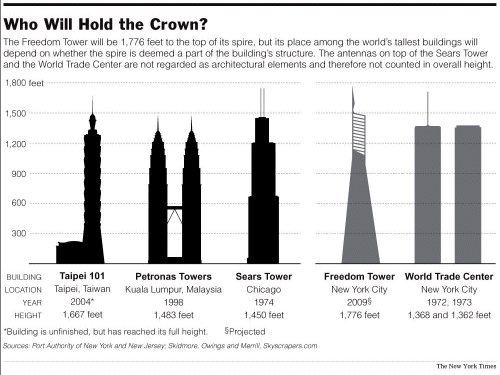
Another piece in the New York Times discusses the politics of highest-building designations:
-
It will certainly be the world's tallest cable-framed, open-air, windmill-filled, spire-studded superstructure, rising atop 70 stories of offices, restaurants, a broadcast center and an observation deck.
Whether that makes it the world's tallest building is another matter. No fewer than a half-dozen times at the unveiling yesterday, the Freedom Tower at the World Trade Center site was called the world's tallest building.
But the Council on Tall Buildings and Urban Habitat, a recognized arbiter, has not yet ruled. And it may be a tough group to persuade. That is because the Freedom Tower will be a hybrid structure with several pinnacles: the top of its enclosed, occupied space is to be at about 1,150 feet; the top of the superstructure at 1,500 feet; and the top of its slender spire at 1,776 feet.
In other words, about one-third of the Freedom Tower will be more of a structural framework than a habitable building. "There are strong feelings on both sides of this," said Ron Klemencic, a structural engineer in Seattle and the chairman of the tall buildings council, which is affiliated with the Illinois Institute of Technology in Chicago. "There's a camp that would say that since so much of the structure is not available to be occupied, it should not be considered the tallest building in the world," he said in a telephone interview on Thursday.
Never mind the Freedom Tower - you can get an argument today about just what is the world's tallest building, even after disallowing cable-supported broadcast towers and agreeing not to count rooftop antennas.
The CN Tower in Toronto unhesitatingly describes itself as the world's tallest building, at 1,815 feet. But some see it is as more of a mast, with a relatively small amount of occupied space. To the council, it is the tallest free-standing structure in the world.
Then comes Taipei 101, a 101-story tower nearing completion in Taiwan, at 1,667 feet, with the top occupied floor at 1,470 feet. The council is inclined to award it the tallest designation, Mr. Klemencic said, but not until it is available for occupancy sometime in late 2004.
That leaves as the reigning champion the 88-story twin Petronas Towers in Kuala Lumpur, Malaysia, which measure 1,483 feet at the top of their spires but only 1,229 feet at their top occupied floors.
The fact that the bulk of these towers is lower than the Sears Tower in Chicago (1,450 feet over all but occupied to 1,431 feet) gave the council pause.
But it decided to recognize spires as the "top of the architecture"; that is, a feature without which the building would look fundamentally different.
Paradoxically, Mr. Klemencic said, the "top of the architecture" criterion had been proposed by an earlier council chairman, Fazlur R. Khan, the engineer at Skidmore, Owings & Merrill who was largely responsible for the Sears Tower. The Skidmore firm is in competition with itself in the perpetual world's-tallest race, since it is also designing a project known as Burj Dubai in Dubai.
Another contender is the Shanghai World Financial Center by Kohn Pedersen Fox Associates of New York.
Whatever it is that Freedom Tower turns out to be the tallest of, in other words, it may not be for long.
- Arik
December 20, 2003
RIAA Dealt a Blow in Verizon Decision
 The Recording Industry Association of America was dealt a major setback in the U.S. Court of Appeals for the D.C. Circuit this week, curbing its ability to sue file-sharers who trade pirated songs.
The Recording Industry Association of America was dealt a major setback in the U.S. Court of Appeals for the D.C. Circuit this week, curbing its ability to sue file-sharers who trade pirated songs.
The court decided that the industry could not force Internet service providers to turn over names of subscribers who trade music because the current law, written in 1998, only allows the industry to request information about subscribers who keep copyrighted material on their ISP's servers, something present-day peer-to-peer file-sharing programs do not do. "It is not the province of the courts ... to rewrite the [law] in order to make it fit a new and unforeseen Internet architecture, no matter how damaging that development has been to the music industry," the author of the majority opinion wrote. The music industry will now have to go through the more cumbersome process of actually initiating lawsuits against anonymous users before the courts can force their identities to be revealed.
Here’s an excerpt from the New York Times:
-
The sharply worded ruling, which underscored the role of judges in protecting privacy and civil rights, is a major setback to the record companies in their efforts to stamp out the sharing of copyrighted songs through the Internet. It overturns a decision in a federal district court that allowed the music industry to force the disclosure of individuals simply by submitting subpoenas to a court clerk without winning a judge's approval.
Until yesterday's ruling, the industry could seek information on file traders without filing a lawsuit or even appearing before a judge, a streamlined procedure that opponents of the industry said did not protect Internet users' rights.
"It's a huge victory for all Internet users," said Sarah Deutsch, vice president and associate general counsel for Verizon Communications, which brought the suit against the Recording Industry Association of America to protect the identities of its Internet customers. "The court today has knocked down a very dangerous procedure that threatens Americans' traditional legal guarantees and violates their constitutional rights."
The appeals court did not directly raise those constitutional issues in its decision. The judges said they were "not unsympathetic" to the industry's troubles in limiting music piracy "or to the need for legal tools to protect those rights." But in a decision that focused narrowly on the nuts and bolts of copyright law, they said that the music industry had gone too far.
Cary Sherman, the president of the recording association, said that the case "is inconsistent with both the views of Congress and the findings of the district court." Mr. Sherman said that his organization would continue to sue those who violate copyrights. It "doesn't change the law, or our right to sue," he said. "It just changes the way we get the information."
The decision is online and is pretty interesting reading. Verizon deserves a few words of thanks from the general public, in my opinion, not because songs will go unprotected, but because Verizon saw how slippery a slope the RIAA’s policy could really be.
- Arik
December 19, 2003
RealNetworks Sues Microsoft for Unfair Competition
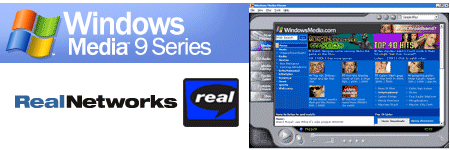
RealNetworks said yesterday it’s suing longtime rival Microsoft, accusing the software titan of unfairly promoting its own software for playing audio and video on computers and over the Internet.
-
In an antitrust complaint filed in federal court in San Jose, California, RealNetworks claimed that Microsoft "pursued a broad course of predatory conduct over a period of years by abusing its monopoly power, resulting in substantial lost revenue and business for RealNetworks." RealNetworks is seeking more than one billion dollars in damages and unspecified injunctive relief measures. "We believe that we have a very strong case against Microsoft," RealNetworks Chief Executive Rob Glaser told reporters on a conference call.
Microsoft rejected RealNetworks claims, saying that there was "vibrant competition" in the digital media player marketplace and that it would respond forcefully to RealNetworks' allegations in court. "Real(Networks) claims to be the No. 1 provider of digital media solutions, with massive distribution of its software and more than 1 million player downloads a week," said Microsoft spokesman Jim Desler, "Thus, this is a case where a leading firm is seeking to use the antitrust laws to protect and increase its marketplace share and to limit the competition it must face."
Seattle-based RealNetworks said that its lawsuit was complementary to an ongoing European Commission investigation into Microsoft's activity involving media-playing software and that it was cooperating with the EC. European Union regulators are wrapping up a five-year probe to determine whether Redmond, Washington-based Microsoft used its monopoly position to boost its share of the media player market. RealNetworks has testified in recent EC hearings.
The two companies, based in the Seattle area, have met frequently in courtrooms over the last five years. Glaser, a former Microsoft executive, founded RealNetworks nearly a decade ago to sell software that allows users to listen to audio and video content on their personal computers.
The two companies were once on good terms, with Microsoft making a $30 million investment in RealNetworks in 1997, but the relationship turned sour after Glaser testified against Microsoft in the U.S. government's antitrust case.
In Thursday's filing, RealNetworks said Microsoft used its monopoly power, which was recognized by the U.S. courts, to force "every Windows user to take Microsoft's media player, whether they want it or not."
RealNetworks, which has been branching out into online content subscription services, sells its media player as a downloadable software product or with a monthly subscription.
RealNetworks said its its complaint that Microsoft went from having no presence in the streaming media business in 1997 to surpassing RealNetworks' digital media player market and usage in the United States in 2002.
Bob Kimball, RealNetworks' vice president and general counsel, said his legal team chose to file its suit in San Jose, California, the heart of Silicon Valley where most of Microsoft's competitors are based, because many of the witnesses are nearby. RealNetworks said it had already spent more than $1.5 million on the litigation during the current quarter and expects to spend $12 million next year.
Meanwhile, Microsoft defended its business practices in the multimedia market:
-
"There is vibrant competition in this marketplace and Real Networks' own reported growth shows that they have thrived on Windows and many other operating platforms," Microsoft said in a statement.
Part of Real Networks' case is based on business conduct similar to what U.S. courts have declared illegal in other Microsoft antitrust cases, such as failure to disclose interface information and placing restrictions on PC manufacturers, said Bob Kimball, Real Networks vice president and general counsel, in the statement.
Such antitrust litigation typically takes about three years with a trial, Real Networks said. Microsoft, for its part, said that computer makers can install and promote any media player on their PCs and that it does not restrict consumers from using any media player. The company called Real Networks' move "rear-view mirror litigation."
"These issues are a rehash of the same issues that have already been the subject of extensive litigation and a tough but fair resolution of the government antitrust lawsuit," Microsoft said in the statement, in turn accusing Real Networks of using antitrust laws "to protect and increase its market share and limit the competition it must face."
Attorneys who have been involved in other legal action against Microsoft said they could see Real Networks' lawsuit coming given its involvement in advising the Department of Justice and the various states in their antitrust cases against Microsoft. "It's not a surprise at all," said Richard Grossman, a partner at Townsend and Townsend and Crew LLP, in San Francisco, and co-lead counsel in a California class-action case that led to a $1.1 billion settlement with Microsoft. "Certainly Real Networks has been at the forefront of those concerned about Microsoft's anti-competitive conduct."
In browsing Real’s Web site today just to re-familiarize myself with a company that had, to be honest, dropped off my radar awhile ago, I found a solid explanation of their competitive advantage over Microsoft, which it seems to consider weaker in many areas than RealNetworks own products. That said, given such an unfair competitive advantage over Microsoft, it might leave some wondering what Real’s lawsuit is really arguing. Here's their top 10 list of advantages:
-
HELIX VS. MICROSOFT: YOU DECIDE
RealNetworks® pioneered streaming media on the Internet in 1995 and has been the leader in technology and business innovations ever since. Today, thousands of the world's leading enterprises, infrastructure service providers, and media companies manage media creation, delivery, security and playback with RealNetworks' end-to-end systems technology.
Why do these companies continue to select solutions from RealNetworks rather than using bundled media software from Microsoft? Review the facts below and decide for yourself whether RealNetworks or Microsoft creates more revenue and cost savings opportunities for your organization.
1. RealNetworks Helix Universal Servers deliver four times more Windows Media streams than Windows Media Servers
In June of 2002, RealNetworks contracted an independent testing facility to benchmark our Helix Universal Server against the Windows Media Technology 4.1 Server. The results were dramatic — Helix Universal Server serves Windows Media better than Windows Media Server. In addition, if you take into account Microsoft's claims regarding performance improvements in their Windows Media 9 Series Beta, RealNetworks Helix Universal Server still delivers nearly double the performance and is shipping commercially today.
2. Is "free" really free?
Because Windows Media is packaged with the Windows operating system, people mistakenly assume that it's free. To use "free" Windows Media software you have to be a paid customer of the Windows operating system. If you want to use the latest Windows Media features, and you have not paid for the latest operating system release, you're out of luck. And to build a robust distributed network for delivering Windows Media, you'll have to pay for expensive third party software or appliances.
3. Helix Universal Server supports all major media formats on an open system, Windows Media is a proprietary, OS-based system.
The RealNetworks Helix Universal Server offers full support for over 55 formats and datatypes - now including streaming Windows Media to Windows Media Players and QuickTime to QuickTime players and MPEG-4 to MPEG-4-enabled players, including the RealOne Player. These products also now offer native support for MPEG4 and MP3 audio.
4. Helix Universal Server runs on 11 operating systems — Windows Media runs on one.
Customers appreciate being able to make their own decision on operating system based on existing resources, skills or their best judgment around security and other issues. The latest version of Windows Media is available with Windows 2000 and Microsoft's upcoming Series 9 release is expected to be available only on the .NET server. This means that with the Helix Universal Server, you will be able to deliver RealMedia and Windows Media from more Windows-based operating systems that you can with Windows Media.
5. Helix Universal Servers slash the cost to deliver both RealNetworks and Windows Media by more than 40%.
Only RealNetworks allows companies to deliver RealMedia, Windows Media, QuickTime and MPEG 4 from a single delivery infrastructure.
6. Helix Universal Server makes delivery of Windows Media reliable
From encoder to server, from server to server or from server to player, the RealNetworks system can be configured redundantly to provide a fail-over feed in the event of a network or equipment outage. Windows Media simply does not have this capability.
7. Consumers overwhelmingly prefer RealVideo 9 to Windows Media Video
By a 16 to 1 Margin, Consumers Favor RealVideo® over Windows Media Video for Better Video Image Quality, Smoother Motion and Overall Viewer Preference — Key Labs, May 2002.
8. How will you reach all platforms and consumer electronic devices?
The Helix DNA Client is at the core of RealNetworks embedded devices strategy. Designed for non-PC devices with constrained footprints and requirements, the Helix DNA Client can support any codec and format. Since its launch in October 2002 the Helix DNA Client has had tremendous success in the market and is being used by tens of thousands of developers as the core media engine for their device or application. The Helix DNA Client, along with the RealAudio and RealVideo codecs, is being ported and optimized for a wide range of devices including mobile handsets, PDAs, set top boxes, home gateways, audio/video servers, and others. In addition, RealNetworks has many relationships with Consumer Electronics manufacturers, chipset / processor / DSP providers, 3rd party software developers, RTOS providers, and others. All are using the Helix DNA Client as their primary multi-format media engine.
9. Can you buy a complete solution for content distribution from Microsoft?
The Helix Universal Server and Helix Universal Gateway offer an integrated content distribution system. Now, from a uniform architecture, digital media can be propagated either proactively or as needed in real time to any place on the network. With Microsoft, you would have to purchase an expensive third party solution for distributed content delivery.
10. How many security breaches can you live with?
RealNetworks has the best security track record in the industry not only because our system has been designed to leverage the intrinsic reliability and security inherent in the most robust operating systems, but because we also offer the most secure digital rights management system available. The RealNetworks Helix Digital Rights Management uniquely offers native, end-to-end and renewable security to unique, tamper resistant playback clients. Because of Microsoft's dependence on the Windows operating system, any OS bugs or breaches will adversely affect the entire infrastructure, including their media server.
Sounds a lot like Netscape a few years ago, doesn't it?
- Arik
December 18, 2003
Windows vs. Lindows

Microsoft is defending itself against another operating system threat in the form of Lindows.com, the San Diego-based company that now faces a penalty of 3 million Swedish Kronas (about $409,000) if it violates a temporary injunction Microsoft was awarded against the company in a Stockholm (Sweden) City Court on Wednesday.
Lindows must stop selling its Linux-based desktop OS products in Sweden, billed as an easy-to-use alternative to Windows, that allegedly violate Windows trademarks, including terms such as "Lindows", "Lindows.com" and "LindowsOS". The legal move to Europe, follows Microsoft’s filing suit in the U.S., an action which is set to go to trial in early 2004.
Meanwhile, Microsoft and Lindows have been going at it on other fronts as well. A Web site set up by Lindows allows California consumers to electronically (and much more easily) file for a share of the $1.1 billion class action settlement by the state against Microsoft, which Microsoft says violates the terms of the settlement. Here’s an excerpt from the article on the Lindows Web site that addresses the issue of settlement rebate vouchers:
-
The clock is ticking for owners of Microsoft products who want to claim their share of the $1.1 billion class-action antitrust judgment against the company. In January, Microsoft agreed in San Francisco Superior Court to pay that amount to California customers to settle 27 lawsuits that accused the software maker of harming consumers with an illegal monopoly.
Much of the $1.1 billion will go to businesses, many of which have bought so much software they will qualify for a rebate of more than $1 million, Crew said. A San Diego Microsoft competitor has come up with another way of processing refunds, but the Redmond, Wash., software maker is trying to block it.
Lindows.com, which sells a version of the Linux operating system, is offering to process vouchers on behalf of customers who use them to buy $50 to $100 worth of software from its Web site at www.msfreepc.com. Although class members can't get their refunds until next summer, Lindows.com is allowing people to get their software free or at a discount right now through the program. It's even giving away a free low-end PC, which it normally is priced at $169, to the first 10,000 people who use the site to claim their vouchers.
Microsoft calls the offer "deceptive" and warns that Lindows .com may not get reimbursed for claims it processes for class members in this unorthodox way. "Right now, the way that (Lindows.com's offer) works is not the way the claims procedure works," said Microsoft spokeswoman Stacey Drake. "We are concerned that the Lindows site misuses the California court-approved process as a marketing tool."
The process for redeeming claims by mailing in a paper form was negotiated between Microsoft and the plaintiffs' attorneys at Townsend and Townsend. But Lindows.com chief executive Michael Roberts said the paper claims process is too inconvenient. "Microsoft made it a very complex process. They don't want people to take advantage of the settlement, because if they don't, Microsoft pays out less money," Roberts said.
Microsoft will get to keep one-third of any unclaimed funds in the settlement, with the remaining two-thirds going to needy California public schools. Like class members, the schools will get vouchers they can use for a wide variety of tech hardware or software.
But Microsoft's Drake said Lindows.com's online process makes it too easy to make a claim, making it more likely that people without legitimate claims will file. Crew, the plaintiffs' attorney, said he has no problem with the Lindows.com system. "We don't see any kind of deception or fraud," he said.
Lindows.com has promised that customers will be allowed to keep the software they bought with the virtual vouchers, whether or not it gets reimbursed through the settlement. In the end, Crew said, the issue of whether Lindows. com gets paid will not be up to him or Microsoft, but the court-appointed administrator who will process all the voucher claims. "The claims administrator has to decide," he said. "That's their job."
In November, Microsoft had filed a court motion to force Lindows to take the site down:
-
As part of the California settlement, consumers who purchased Microsoft products between Feb. 18, 1995, and Dec. 15, 2001, can apply to receive vouchers for refunds on future purchases of computer products and software after filling out a series of forms. The MSfreePC.com site prompts consumers to answer a series of questions to see if they qualify for a portion of the settlement. If they do, they then can access the Lindows desktop Linux operating system and other software that competes with the Microsoft platform.
Microsoft, in its latest court motion, wants any claims from MSfreePC.com to be rejected because it says the antitrust settlement requires consumers to physically sign claims forms, while the site only requires a digital signature. Microsoft also says that consumers must essentially transfer their claims to Lindows.com in order to receive access to software in violation of the settlement agreement's rules.
Lindows.com defended its MSfreePC.com site on Monday, saying that it meets the "letter and the spirit of the antitrust settlement."
Lindows.com CEO Michael Robertson, in a statement, criticized Microsoft for using digital signatures itself while disputing their validity in the antitrust settlement and said that Microsoft's actions are an attempt to reduce the amount its pays out. Lindows.com plans to submit a rebuttal to Microsoft's motion within the next two weeks.
Along with the rejection of claims from MSfreePC.com, Microsoft also wants the administrator of settlement claims to tell consumers that the Lindows.com site is not authorized and point them to the official settlement Web site, www.microsoftcalsettlement.com, and to mail the paper claim forms to any consumers whose claims are rejected in the Lindows.com dispute.
Since the Swedish court ruling last week, European resellers have been caught in the crossfire, with Lindows distributors throughout the continent being threatened with legal action until the Lindows name is changed:
-
The injunction is the latest salvo in an increasingly nasty war in which Microsoft appears determined to quash the Lindows name permanently. "What we're asking Lindows to do is to change its name," says Microsoft spokesman Jim Desler. "It is Lindows.com that put these [European] resellers in a compromising position by their deliberate infringement on our trademark."
Lindows.com Chief Executive Officer Michael Robertson isn't one bit happy. "It is another example of Microsoft attempting to eradicate all competition through any means," Robertson told a group of European resellers. "While they say they invite competition, behind the scenes they seem willing to take any actions - including blatant extortion - to squash competition."
In November, resellers in the Netherlands got tangled up in their own Lindows skirmish. They cried foul after receiving telephone calls from Microsoft allegedly threatening them with possible legal action if they continued to sell the maverick, Linux-based operating system.
On Nov. 25, Dutch reseller Hans de Vries, owner of DV Computer Systems, informed Robertson that Microsoft was about to drag his company into litigation against the Lindows name in the Netherlands. "What I understand from that phone call is that they want that I stop selling Lindows OS computers," de Vries wrote in an e-mail message. "I don't like this but when they are taking this to court and involve me then I must stop selling Lindows OS because I don't have the money for lawyers," de Vries continued.
An angry Robertson branded the threats as "blatant extortion" and responded by jetting to Amsterdam, kicking off a weeklong trip designed to support international resellers of LindowsOS who have, according to a Lindows.com statement, "endured harassment from Microsoft."
Microsoft's tactics are not keeping Robertson from moving ahead with a new product. "We're now launching LindowsOS 4.5 in Europe as a show of support for our resellers, who Microsoft is threatening with legal action if they continue to sell Lindows.com products," says Robertson.
As for Microsoft's view of the operating system itself, Desler says there's no problem. "There are many Linux-based operating systems out there, and we don't have an issue with any of them. The only problem we have with Lindows is the name. This is a clear case of trademark infringement."
In the United States, however, that question has yet to be decided. On Dec. 20, 2001, Microsoft filed a complaint in the U.S. District Court for the Western District of Washington against Lindows.com, alleging trademark infringement, trademark dilution, unfair competition and unfair business practices.
At that time, Microsoft requested a preliminary injunction enjoining Lindows.com from using the Lindows trademark "in the promotion, advertising, marketing, or sale of a software product in competition with Windows." Two subsequent rulings denied Microsoft's request for an injunction, and raised questions about whether the term "windows" is a protectable trademark. A jury trial to determine the trademark's validity is slated to begin in March 2004.
Robertson is no stranger to controversy: In 1997, he launched the digital music Web site MP3.com. Facing its own legal battles, the site was purchased by Vivendi Universal and, in November 2003, sold to CNET Networks Inc.
So, the real question revolves around whether Windows is a Microsoft trademark then. I don't know of many computer applications that would be so inextricably linked to Microsoft - other than maybe "office". But, if Microsoft loses this fight on those grounds, they've certainly done themselves more harm than good...
- Arik
December 17, 2003
Return of the King: Christmas' Top Film, a Big Best Picture Contender at Oscars

"The Lord of the Rings: The Return of the King" opens today and there's already a glowing review from Slate.com. It'll be a tough film to beat this Christmas week as Peter Jackson unleashes his final installment of Tolkien's trilogy on the movie-theater competition.
Plus, when all the fighting's done, I think Jackson & Company will kill 'em at the Academy Awards in February too, walking away with the Best Picture Oscar for 2003.
- Arik
December 16, 2003
Abercrombie & Fitch: Accusations of Racism in Sales Staff Hiring

CBS News’ program "60 Minutes" did a piece recently by Morley Safer on Abercrombie & Fitch and accusations of racism in their hiring practices for in-store sales associates – essentially that, the company excludes people of color from jobs, hoping to sell clothes to a particular (racial) demographic… e.g., white. The excerpt below is from the conclusion of the piece, but you can read it all for yourself online. In light of their recent pulling of the controversial catalog in the past few days, this other bit of bad press is probably not what they were hoping for as a Christmas present.
-
After bankruptcy and buyouts a few years ago, Abercrombie decided on a major face and body lift. Out went the camping gear - and off came the clothes.
Abercrombie’s image is now party-loving jocks and bare-naked ladies living fantasy lives. Nubile young store "greeters" stripped down during the holidays to boost up sales. Flipping through their catalogs, you now might wonder what Abercrombie is selling. Could it be clothes?
"Sex sells with any age group, and that’s what they’re trying to do," says Elizabeth Nill, a sophomore at Northwestern University. Elizabeth and her friends feel that Abercrombie & Fitch has a certain something.
"I would describe it as the all-American look. I know it's very cliché," says Elizabeth. "But I don't think there's really any other way to describe it."
In fact, she enjoyed shopping there so much that she is often asked if she wants a job. She says it’s happened to her about five times, in three different stores.
And it’s not by accident. Abercrombie & Fitch wants a sales force that reflects what’s up on its walls - cool yet seductive.
"The skirts are getting shorter. The tops are getting smaller," says Elizabeth. "That seems to be the trend and Abercrombie is going with that."
But Abercrombie & Fitch, the reputation that it once had was a very classical, classy look. That’s long gone. Now, the provocative strategy aimed at teens and twenties has done wonders for Abercrombie’s bottom line. And of course, the more parents are outraged, the bigger the sales. And now with more than 600 stores and annual revenues well over $1 billion, Abercrombie & Fitch has become just about the largest teen retailer on the block - and a mainstay of "Generation Y" couture, and even its music.
But all that fair hair and skin has made them a juicy target. They’re being taken to court, accused of racial discrimination in their hiring. Does Abercrombie’s all-American look exclude some Americans?
"All-American doesn't mean all-white," says Jennifer Lu, a student at University of California, Irvine and a former salesperson at a Costa Mesa store. Lu and several other young people say they couldn’t get a job or were fired because their "look" was not consistent with the Abercrombie "look."
"It’s dominated by Caucasian, football looking, blond hair, blue eyed males. Skinny, tall," says Lu. "You don't see any African American, Asian Americans And that's the image that they're portraying and that they're looking for."
Lu says she was fired after corporate officials visited the store, and according to her, didn’t like what they saw: "A corporate official had pointed to an Abercrombie poster and told our management at our store, ‘You need to have more staff that looks like this.’ And it was a white Caucasian male on that poster."
She says shortly thereafter that several Asian-American salespeople were fired and replaced with white males.
Anthony Ocampo says blacks, Asians and Latinos were sometimes hired by Abercrombie, but he says "the greeters and the people that worked in the in-season clothing, most of them were white, if not all of them were white. The people that worked in the stockroom, where nobody sees them, were mostly Asian American, Filipino, Mexican, Latino."
Ocampo worked four years ago as a sales rep at an Abercrombie store during his Christmas break from Stanford University. He says he assumed his job would still be available when he returned home that summer, but when he turned up for work he found out he lost his job.
"’We're sorry. We can't rehire you because we already have too many Filipinos working at this store,’" recalls Ocampo. "Too many Filipinos. That was her exact words … I was speechless. I didn't really know what to say. I've never seen racism that explicit prior to that."
The closing quote from the piece: "... their all-American image does not mean all white. That's not right. That's not legal," says Lu. "That's what we grew up learning all-American to be. All-American, a melting pot. Not all white."
- Arik
December 15, 2003
Miller Lite vs. Coors & Bud: the Low-Carb Campaign & Lite's Sudden Sales Surge
 Miller Lite's pushing its low-carb qualities, playing to the diet trends of the past few years, has it seeing a dramatic sales increase lately challenging Coors Light, which finished last year as the country's number two beer, to top brew Bud Light. Here's an excerpt from AdAge:
Miller Lite's pushing its low-carb qualities, playing to the diet trends of the past few years, has it seeing a dramatic sales increase lately challenging Coors Light, which finished last year as the country's number two beer, to top brew Bud Light. Here's an excerpt from AdAge:
-
Sales for long declining Miller Brewing Inc. brand have risen in the past 13 weeks, since the brewer launched TV spots comparing its carbohydrate and calorie content to rival Adolph Coors Co. and Anheuser-Busch brands. Industry insiders credit the campaign for the boost.
"Bud Light and Coors Light are vulnerable and this is the first time we've been able to say that in years," crowed a southwestern Miller distributor.
Miller Lite's volume gain in both supermarkets and convenience stores outpaced both Bud Light and Coors Light for the 13 weeks ended Nov. 22, according to AC Nielsen data. Miller Lite rose 0.6 of a share point, while Bud Light's volume share was up half a point and Coors Light fell 0.2 share points. In convenience stores, Miller Lite's share was up 0.1 point, while Bud Light and Coors Light were flat.
More surprising, in both channels, Miller Lite drove total Miller sales up to lead the three breweries in share growth, while Coors was flat to down and Anheuser-Busch's share dropped 0.7 share points. That's a big turnaround, since Miller has declined since it relinquished the top beer spot in 1994 to Bud Light.
"It would be fair to say Miller has flip-flopped [brand positions] with Coors," said one multibrand distributor in the Central U.S.
Coors, however, isn't sitting still. Last week the brewer broke a new spot attempting to advance its own low-carb message. In the spot, Coors asserts the difference between its brand and Miller Lite is just 1.8 carbohydrate grams, which can be burned off doing a slow dance. The week before, Coors said it would launch a super-premium low-carb brand called Aspen Edge early next year.
"Some marketers are misleading consumers about carbohydrates," said a Coors spokeswoman. "Consumers ... are surprised to learn that Coors Light has only 5 grams of carbs for a 12 ounce serving."
Those close to Coors acknowledge that Miller is making a dent in their share. "Coors was down last year so this is not fair to attribute all of the softness on Coors Light to Miller but Miller has clearly exacerbated Coors problems," said an executive close to Coors.
Miller has been spending heavily to achieve the gain. The brewer has pushed out at least a dozen spots in as many weeks to promote Lite. "Spending is way up," said a Miller spokesman, to about equal "what Anhesuer-Busch spent last year at this time."
Ironically, observers credit Anheuser's Michelob Ultra for carving out the niche that is helping Miller Lite. "We were seeing 2% to 3% declines prior to Michelob Ultra and now we're seeing double digit growth," said the multibrand distributor.
"Every time Michelob Ultra runs an ad it helps Miller Lite," added the distributor.
Now, that's ironic - piggybacking Lite on top of rival Michelob's Ultra, that is - an unintended side-effect of the low-carb trend that launched Ultra into the brand stratosphere, despite the taste. It's even more interesting that Lite made no product adapatation to meet the trend, so it's a cheap repositioning from a product development perspective - in other words, they got lucky by having a beer with only 3.2 carbs to begin with. Here's another excerpt:
-
In addition, Miller Lite Dec. 5 broke a new branding spot called "Epidemic" from WPP Group's Y&R Advertising, Chicago, that ramps up the "uncompromised taste" position. In the spot, a guy sitting in bar drinking a competitive beer looks at it and says, "I can't taste my beer." Others chime in and run into street shouting "I can't taste my beer." The spot ends with three enjoying their beer, which turns out to be Miller Lite.
- Arik
December 14, 2003
Capturing Saddam Hussein: Implications for Geopolitical Scenarios, Debt Restructuring, Competing for Iraqi Reconstruction Business & the American Race for President

With the capture of Saddam Hussein at 8:26 p.m. Baghdad time on Saturday night, in an operation code-named Red Dawn, the dynamics of every question surrounding Iraq was suddenly altered, and the ex-post-facto analysis is a fascinating resurfacing of the field for a number of competitive battles from a business perspective, as well as highlighting a major intelligence success just when it was needed the most.
A member of Saddam Hussein’s Tikriti clan, captured in a raid on a Baghdad safehouse on Friday as U.S. intelligence began targeting mid-level family members and other allies, told interrogators he could be hiding at one of two farms near the town of Ad Dwar, just ten miles from Tikrit and even nearer to Hussein's birthplace, Uja. Curiosly, U.S. troops had searched that same area only two weeks ago. Soldiers first thought they might’ve missed Saddam again, but when they saw two men running away, the C.O. conducted a more thorough search. Hussein was found six feet below a concealed Styrofoam hatch over a ventilated crawlspace.
What will Iraq look like, geopolitically, now that the spectre of a return-to-power by the Iraqi tyrant has been lifted? Since Iraq is a post-WWI artifice constructed from Britain's imperial pull-out in the 1930's, Saddam Hussein fulfilled the role of dictator in a state so culturally schizophrenic because of Kurdish, Sunni and Shia nationalities that perhaps only a dictator could hold it together. The geopolitical question now is whether Iraq will follow the Yugoslavian Model (decades of civil war as the artifical state eventually fails and fractures anyhow) or the Spanish Model (using inherent strengths, such as Spain's unifying religion, to strengthen the political ties that bind them)?
Gen. Raymond Odierno, commander of the Fourth Infantry Division that caught Hussein thanks to "actionable intelligence" created by joint CIA-Special Operations "Task Force 121" described their approach: "We tried to work through family and tribal ties that might have been close to Saddam Hussein," Odierno said, as quoted in the WP. "As we continued to conduct raids and capture people, we got more and more information on the families that were somewhat close to Saddam Hussein. … And finally we got the ultimate information from one of these individuals."
The Bush administration wanted to confirm Saddam Hussein's identity before leaking rumors could steal their thunder or a case of mistaken identity made them look foolish – the former happened after the deaths of his two sons, Uday and Qusay. Hussein’s scruffiness helped from a psy-ops perspective. "Our planning was good," the director of strategic communications for the Coalition Provisional Authority told the New York Times. "But Saddam helped it immeasurably in the long run. He contributed in ways we never dreamed possible - he allowed himself to get into such a disheveled state and to look so haggard."
Meanwhile, the U.S. Army is already making hay of the juicy tidbits of intel found in Saddam's briefcase:
-
Saddam Hussein's capture is already reaping dividends for the U.S. military, providing intelligence that allowed U.S. soldiers to capture several top regime figures and uncover rebel cells in the capital, a U.S. general said Monday.
The U.S. military hopes Saddam will clear up allegations that he had chemical and biological weapons and a nuclear weapons program, said U.S. Army Brig. Gen. Mark Hertling of the 1st Armored Division. "I certainly think some of that will come out," Hertling said in an interview with The Associated Press. "I think we'll get some significant intelligence over the next couple of days."
Since Saddam's capture on Saturday, U.S. Army teams from the 1st Armored Division have captured one high-ranking former regime figure - who has yet to be named - and that prisoner has given up a few others, Hertling said. All the men are currently being interrogated and more raids are expected, Hertling said.
The intelligence that led the military to the men came from the first transcript of Saddam's initial interrogation, and a briefcase of documents Saddam carried with him at the time of his arrest, Hertling said. "We've already gleaned intelligence value from his capture," Hertling said. "We've already been able to capture a couple of key individuals here in Baghdad. We've completely confirmed one of the cells. It's putting the pieces together and it's connecting the dots. It has already helped us significantly in Baghdad." The intelligence has also given the U.S. military a far clearer picture of the guerrillas' command and control network in the city, and has confirmed the existence of rebel cells whose existence was previously only suspected, Hertling said.
From the initial batch of successes, Hertling said it was apparent that Saddam still played some role in leading the anti-U.S. insurgency. "I'm sure he was giving some guidance to some key figures in this insurgency," Hertling said. Hertling said the 1st Armored Division had also received intelligence from other sources on attacks Monday in Baghdad. The division received tips earlier in December that a spate of car bombings would start in mid-December. "We have some intelligence that things are going to happen," Hertling said.
Hertling said he hopes Saddam will divulge secrets on everything from mass grave sites to the whereabouts of missing regime figures and "past sins of the regime we may not even know about." "We certainly can gather intelligence he has on the organization of the insurgency, who their leaders are, how the cells are performing, how they're being commanded and controlled, who's funding them and what their connections are to crime," Hertling said.
And, the American intelligence community has been vidicated after a long couple of years of less-than-stellar performance:
-
For American intelligence agencies, the capture of Saddam Hussein is a much needed vindication after many months of failures and frustrations, Bush administration officials and members of Congress said Sunday.
The agencies' standing was brought to a low ebb by a long line of setbacks, including the failure to anticipate the attacks on Sept. 11, 2001; the unsuccessful search for unconventional weapons in Iraq; and the inability to find Mr. Hussein or Osama bin Laden. But that string has ended in the dirt hole where Mr. Hussein was finally found, not far from his birthplace.
Although it was American soldiers who unearthed Mr. Hussein, it was the intelligence community, including the Central Intelligence Agency and its military counterparts, that set them on the right path, beginning with a new analytical effort begun in late November to draw up a list of just who might be hiding him.
As American generals, diplomats and President Bush himself announced the capture in Washington and in Baghdad on Sunday, intelligence officials, including George J. Tenet, the director of central intelligence, were nowhere to be seen. But Mr. Bush himself used his televised address in part to praise what he called "the superb work of intelligence analysts who found the dictator's footprints in a vast country."
Behind the scenes, the C.I.A. and its counterparts have scored some important victories, including work that has led to the killing and capture of high-ranking members of Al Qaeda. But since the Sept. 11 attacks, the intelligence agencies' public record has been checkered at best, beginning with what a Congressional review called a failure to connect the dots in analyzing intelligence that could have provided warnings of the hijackers' intentions. Mr. bin Laden, the Qaeda leader, has succeeded for more than two years in eluding a hunt by the military and intelligence agencies.
The intelligence agencies are now widely seen as having overestimated the threat posed by Mr. Hussein's government before the war, in particular saying that it had stockpiled prohibited weapons, which so far have not been found. During the war itself, two failed attempts to decapitate Iraq's Baathist leadership with airstrikes aimed at Mr. Hussein on March 19 and April 7 underscored the limitations of information provided by the agencies.
Against that backdrop, senior members of Congress who have been critical of the C.I.A. in recent weeks went out of their way on Sunday to give the intelligence agencies what they called their due.
"Saddam's capture is a direct result of unprecedented cooperation and joint effort on the part of our intelligence analysts, operators in the field and our military," said Senator Pat Roberts, a Kansas Republican and chairman of the Senate Intelligence Committee. He said they "deserve a great deal of credit and our gratitude."
Senator John D. Rockefeller IV of West Virginia, the top Democrat on the Senate Intelligence Committee, described the capture as both "a remarkable achievement" and "a classic intelligence operation of persistence and analysis."
C.I.A. officers have played a major part in the supersecret military Special Operations teams, including Task Force 121, that were given the leading role in tracking down Iraqi leaders. In recent weeks, the information gathered by the C.I.A., the Defense Intelligence Agency and the intelligence arms of the military services has been closely shared among the agencies through a new cooperative arrangement in Baghdad.
It was human intelligence, rather than the kinds of information gathered by spy satellites or eavesdropping, that led the United States to Mr. Hussein, the senior American officials said.
Human intelligence was always the weakest link for the United States in Iraq, American officials say, and that capability deteriorated during the 1990's as a result of deep budget cuts. Before the United States invaded Iraq last March, the agencies drew up lists of the Iraqi officials whom they most hoped to capture. But it was apparently not until last November, after months of work in developing new intelligence about Iraq, that a new list pointed the American search effort in the direction that finally proved fruitful.
"I suspect that it will be some time before a settled peace resides in Iraq," said Representative Porter J. Goss, a Florida Republican and chairman of the House Intelligence Committee. "Nevertheless," he said of the insurgents, many of them loyal to Mr. Hussein, who have been attacking Americans, "this is the beginning of their end."
Saddam’s capture comes even as President Bush was defending a policy stance last week to prohibit prime contracts – or even competition for them – in the lucrative post-war Iraqi reconstruction from going to countries that opposed the Iraqi war.
Indeed, this policy recently drew the ire of Germany, France and Russia, as James Baker, the supremely qualified deal-making friend of the Bush family, takes to the road to restructure Iraq’s international debt (Baker’s potential conflicts of interest in this new role were explained in a NYT editorial last week).
I believe the reconstruction lockout and the debt question is intimately linked – it’s a bargaining chip, rather than an irony. Baker can use it to negotiate debt restructuring in return for allowing German, French and Russian firms access to competition for reconstruction contracts.
The New York Times also has a really interesting account of a meeting Sunday afternoon between Saddam Hussein, L. Paul Bremer III, the American civilian administrator of Iraq; and Lt. Gen. Ricardo Sanchez, the top military commander in Iraq, along with four Iraqi leaders: Mowaffak al-Rubaie, a Governing Council member ; Ahmad Chalabi, a council member and head of the Iraqi National Congress; Adnan Pachachi, a council member who was the foreign minister before Hussein came to power; and Adel Abdel Mahdi, who represents the Shiite religious body, the Supreme Council for the Islamic Revolution in Iraq.
Finally, Saddam's capture also opened an opportunity for other Democratic candidates for President to slam Howard Dean, who has based much of his campaign on opposition to the war in Iraq. "The fact is that if Howard Dean had his way, Saddam Hussein would still be in power today, not in prison," said Connecticut Senator Joe Lieberman, a leading Democratic backer of the war.
This was the second big event in a week that shook up the Democratic race. Just Tuesday, former Vice President Al Gore endorsed Dean, citing his opposition to the Iraq war. Missouri Rep Dick Gephardt said in a statement, "I supported this effort in Iraq without regard for the political consequences because it was the right thing to do... I still feel that way now and today is a major step toward stabilizing Iraq and building a new democracy." But, retired General Wesley Clark still thinks going to war in Iraq was unnecessary. "It seems to me that all of the concerns that I have voiced about Iraq remain I stand by every concern," Clark said in a conference call from The Hague, where he was testifying in the U.N war crimes trial of former Yugoslav President Slobodan Milosevic. Democrats have been slamming Bush for failing to capture Saddam and Osama bin Laden, in spite of months of manhunting. Ohio Representative Dennis Kucinich and activist Al Sharpton said the United States must now focus on getting our troops home and out of Iraq.
The LA Times had a nice analysis of how the Democratic pack will try to use Hussein's capture against front-runner Howard Dean longer-term. Having Hussein in custody could cause problems for the Democrats if their presidential nominee is, like current front-runner Howard Dean, defined by opposition to the war. This all follows a steady upswing in economic indicators, with the stock market and overall growth increasing substantially this fall, strengthening President Bush considerably. Greater stability in Iraq and a recovering economy would provide for a peace and prosperity environment that will make him very tough to beat. Here's an excerpt:
-
But its reverberations could be felt immediately in the Democratic race for the nomination, where Dean has surged ahead over the last six months in part by stressing his opposition to the war in Iraq.
Since Bush declared the end of major combat operations in Iraq in May, the Democratic race has been heavily influenced by a complex dynamic: Any reversal in Iraq that strengthens the Democrats against Bush also has strengthened Dean, the most vocally antiwar of the major candidates, against the rest of the field.
The question now may be whether the reverse is true — whether good news in Iraq will be bad news for Dean. The candidates chasing him quickly made clear that they hoped so.
Kerry, who only days ago was stressing the similarity between Dean's views and his own in the period before the war, insisted Sunday that the capture raised questions about Dean's foreign policy judgment. Kerry suggested that Hussein's capture validated his 2002 vote for the congressional resolution authorizing the war.
"This is a time that underscores that, if we are going to beat George Bush, we need somebody who has experience and who got this policy right," Kerry told reporters in Davenport, Iowa.
Without criticizing Dean by name, aides to Clark also insisted that Hussein's capture showed the need for a candidate with credentials to compete with Bush on foreign policy.
"Today's development reinforces that the major issue in the 2004 election is going to be national security," said Chris Lehane, a senior Clark strategist. "The Democrats need a candidate who can meet the commander-in-chief test in next year's election."
Lieberman took the hardest line, denouncing Dean, praising the capture in unqualified terms — "Hallelujah, praise the Lord," he said on NBC's "Meet the Press" — and calling for Hussein to be tried before a body that could sentence him to death.
On his campaign plane during a flight from Palm Beach to San Francisco on Sunday afternoon, Dean declined to respond to the comments made by his rivals. "Today is not a day for politics," Dean said. "Today is a day for celebration."
It should be telling to see where this takes us in the months ahead. For the Iraqi people, it really is a day to celebrate. The spectre of Saddam has been lifted and, psychologically at least, the country can begin to heal from a generation of murder, theft and lies at the hands of a tyrant.
- Arik
December 13, 2003
AT&T and Qwest Jump Aboard VoIP Bandwagon, Following Time Warner Cable Deal with Sprint & MCI
 AT&T and Qwest both joined the VoIP fray, along with Sprint and MCI's allegiance with Time Warner Cable, carving out the entry of big telecom into the emerging, fast-growth market that is rapidly commoditizing their existing local and long-distance businesses. The only question I have is, what took them all so long? I've had Vonage service for over nine months now as my primary landline after my cable company - Charter - couldn't say when they'd start rolling VoIP dialtone to my highspeed cable modem line. If you're a cable company thinking of entering this market, the calendar just got a lot tighter.
AT&T and Qwest both joined the VoIP fray, along with Sprint and MCI's allegiance with Time Warner Cable, carving out the entry of big telecom into the emerging, fast-growth market that is rapidly commoditizing their existing local and long-distance businesses. The only question I have is, what took them all so long? I've had Vonage service for over nine months now as my primary landline after my cable company - Charter - couldn't say when they'd start rolling VoIP dialtone to my highspeed cable modem line. If you're a cable company thinking of entering this market, the calendar just got a lot tighter.
My thoughts are that this most recent round of initiatives is the Telecom Act coming home to roost in the free-for-all world of Internet communications. Regardless, it’s good to see some competition for Vonage in the space, as the plans promise to lower the cost of phone service more broadly and include new features (which I’m already used to, thanks very much), like the ability to check voice mail or program call-forwarding requests on the Web. But, until now, VoIP has been pretty much a niche service, as fewer than 200,000 Americans use Internet phone service as their primary line, according to TeleGeography.
But, that penetration is sure to soar in 2004. Besides the announcements made this week, the nation's biggest phone company, Verizon, plans to deliver a consumer Internet phone offering within the next six months. Here’s a press excerpt on recent events, that explains the technology pretty well too:
-
"The giants getting into the business gives Voice Over IP credibility," said Guzman & Co. analyst Pat Comack, using the technology's official name. "People will give it a shot now. All of a sudden, this is not a toy anymore."
But while the Internet phone bandwagon swells, the full-fledged revolution seems several years away. For now, only the roughly 20 percent of U.S. households that have broadband Internet access can use the technology.
Perhaps most importantly, special steps have to be taken to make the Internet phone systems connect to 911 dispatch centers or work in blackouts like the old-fashioned phone network can.
"I'm not going to pretend that we're ready to solve those problems," AT&T spokesman Gary Morgenstern acknowledged Thursday. "We're working on that."
Other providers say they have addressed those issues. Internet phone pioneer Net2Phone, which is focusing on helping cable companies deliver the service, boasts that it also has overcome the technical hurdle of letting law enforcement officials set wiretaps, which phone companies are required to allow.
Traditionally, a phone conversation is converted into electronic signals that follow an elaborate network of switches in a dedicated circuit. Long-distance calls cost more because regional carriers have to be paid for originating and terminating the calls.
The new technology has a terribly nerdy name, Voice over Internet Protocol - or Voice over IP or just "VoIP" - but its premise is pretty simple.
When a call is made, the sounds are converted into packets of data that take diverging paths around the Internet or private networks, just like e-mails or Web pages. The packets get reassembled as sound on the other end of the call. The sound quality sometimes strays from perfection - though it has come far in recent years and is expected to get even better.
The process is cheaper because it cuts some or all long-distance access charges out of the equation - though that is a contentious issue under consideration by the Federal Communications Commission. It also helps big businesses save money because they can use their expensive data networks to make phone calls instead of only shuttle files around. And because voice is sent like any other kind of data, new videoconferencing services and Web-based phone messaging applications are possible. The address book in an e-mail program can dial a number with the click of a mouse.
Combine all those elements, and VoIP represents a tidal wave.
Providing service costs Vonage about 1 cent a minute; AT&T probably could do it for about seven-tenths of a cent because it has its own vast data network, says UBS Warburg analyst John Hodulik.
With such low costs, charging for long-distance by the minute will probably give way to "all you can eat" plans. For example, Time Warner Cable lets its Internet customers in Raleigh and Portland make as many calls as they want for $39.95 a month.
Also, cable TV companies increasingly will use VoIP to sell phone and broadband service in an attractively priced "bundle" that makes customers less likely to leave. In response, phone companies might have to accelerate plans to upgrade to fiber-optic lines that can carry a huge amount of bandwidth, including ultra-fast Internet and high-definition TV.
In the meantime, the billions of dollars worth of copper phone wires spread across the country figure to gradually become obsolete. AT&T stopped investing in the old-style "circuit-switched" infrastructure several years ago, opting instead to build only data networks.
"It's not a question of if," said Forrester Research analyst Charles Golvin. "It's a question of when."
The earlier announcement by Time Warner Cable that it is working with Sprint and MCI to offer phone service using VoIP is one of the surest signs yet that cable companies are going to war with the local phone industry. Here's another excerpt (paraphrased):
-
While other cable companies sell phone service to their customers in selected markets, the deal announced last Monday is the first time VoIP will roll to nearly nationwide phone service by a cable company.
"We've moved out of the talking stages and into the reality," said Jeff Kagan, an independent industry analyst based in Atlanta. "2004 is going to be the year cable and phone companies get into each other's business and start competing."
At a switching station, the calls will be transferred to either the MCI or Sprint phone networks and into the traditional format that reaches most phone users. Improving quality gives cable companies an efficient way to break into the phone business. Meanwhile, telephone providers are increasingly going after the cable companies by cutting prices on digital subscriber line (DSL) high-speed Internet service and by bundling satellite TV service with local phone bills.
Sprint and MCI said they were in talks to facilitate phone service for other cable providers but provided no other details. "It's a whole new business for Sprint and MCI to get into," Kagan said. "It helps to diversify the business. It's a whole new revenue stream for Sprint and MCI and it's a huge opportunity because Time Warner is just one of many cable companies they can work with. This is just what the long-distance industry needed." The companies provided no details about how much the deal was worth.
Time Warner's cable and high-speed data customers in Portland and Raleigh pay $39.95 for unlimited local, in-state and domestic long distance calling. Customers that don't receive other Time Warner services pay $49.95 a month for phone service. Time Warner Cable spokesman Keith Cocozza said prices will remain similar when the program is expanded nationally. "What we've always wanted to do is offer our customers a wider range of services for the best value," Cocozza said. He said voice-over-IP "allows us to get into a market we haven't been in."
Martin Dunsby, an analyst at consulting firm inCode Telecom Group, noted that the technology also provides consumers with other options because the calls are carried by lines that can handle other kinds of data as well. That makes picture messaging and video conferencing possible.
"Really, it means more choice for consumers," Dunsby said. "Instead of having to go to the local phone company for phone service and cable company for cable you can go to a range of providers for a range of services."
It's a shrewd move that allows Time Warner Cable to leap a big hurdle, by using Sprint and MCI to provide interconnection facilities, long distance traffic, 911 service, relay systems and operator services. The service, which will be called Digital Phone, includes unlimited local, in-state and domestic long distance, and customers who add the service will be able to keep their existing phone numbers. Time Warner Cable has 10.9 million subscribers in 27 states. A spokesman for Sprint said the 17 markets that Sprint will service are about half of the total markets covered by the three-year agreement. MCI will cover the rest.
VoIP trials have varied a lot in how they packetize voice, and few carriers are ready to move directly to an IP-based client using the Session Initiation Protocol, or SIP, in phones or PCs. Instead, most services will use existing analog handsets, converting to packet at an aggregation gateway.
Even this partial offering carries immediate benefits, as in the case of AT&T, which can offer flat-rate service for both local and long-distance by transporting all voice traffic as packets. One financial analyst who covers AT&T said "the first impact will be to create more vicious competition between interexchange and local carriers, with prices dipping so low [that] some carrier operating expenses could suffer. The second impact will be to hammer the specialized long-distance providers who use a leased interexchange carrier. Without direct access to transport, they won't be able to meet the VoIP challenge."
Following a ruling by Minnesota's Public Service Commission regarding regulation of VoIP services from Vonage, Qwest will offer VoIP service in Minnesota, using either IP phones or analog phones with adapters, linked to DSL modems. The service, already available in some Minneapolis-St. Paul neighborhoods, will be expanded to most of Qwest's 14-state region in the first half of 2004. AT&T announced it would offer IP-based local and long-distance phone service to its customers with broadband access, enabling most services within 2004.
My analysis: the real killer app here is Unified Messaging, not Bundled Services. It should be interesting to see where commoditization takes prices next year - and the effect it'll have on the growth wireless telecoms have enjoyed of late - still, I think anybody who competes on price instead of features is probably doomed. I've found that a VoIP landline and a cell phone I can auto-forward it to if I don't pickup at home, makes for a real - and cheaper - telecom solution.
- Arik
December 12, 2003
The Medicare Drug Benefit & Why Seniors Are So Spoiled
 In the wake of the Medicare drug benefit legislation President Bush signed this week, I was browsing Steve Chapman's biting piece on Slate, "Meet the Greedy Grandparents: Why America's Elderly are so Spoiled". As we look forward to future generations of Americans having footing the bill for today's free drugs to keep aging Baby-Boomers chugging along into their hundreds, the subject of entitlements for seniors - whether that's ensuring the Social Security safety net or making sure drug companies don't profit unfairly by "forcing our seniors to choose between whether to buy food or their arthritis medicine" (in the words of our President) - we should consider remember that senior citizens have never had it so good in these United States, and if not for their huge voting bloc, they wouldn't be so well off.
In the wake of the Medicare drug benefit legislation President Bush signed this week, I was browsing Steve Chapman's biting piece on Slate, "Meet the Greedy Grandparents: Why America's Elderly are so Spoiled". As we look forward to future generations of Americans having footing the bill for today's free drugs to keep aging Baby-Boomers chugging along into their hundreds, the subject of entitlements for seniors - whether that's ensuring the Social Security safety net or making sure drug companies don't profit unfairly by "forcing our seniors to choose between whether to buy food or their arthritis medicine" (in the words of our President) - we should consider remember that senior citizens have never had it so good in these United States, and if not for their huge voting bloc, they wouldn't be so well off.
Here's a choice excerpt:
-
From gratefully accepting a basic level of assistance back in the early decades of Social Security, America's elderly have come to expect everything their durable little hearts desire. They often get their way, as they did recently when years of complaints finally induced Congress and the president to agree to bear much of the cost of their prescription drugs. From the tenor of the debate, you would think these medications were a terrible burden inflicted by an uncaring fate. In fact, past generations of old people didn't have to make room in their budgets for pharmaceuticals because there weren't many to buy. If you suffered from high cholesterol, chronic heartburn, or depression, you were left to primitive remedies, or none. Today, there are pills and potions for just about any complaint—except the chronic complaint that many of them are pricey. It's not enough to be blessed with medical miracles. Modern seniors also want them cheap, if not free.
Here's another:
-
Why do we keep indulging the grizzled ones? The most obvious reason is that they are so tireless and well-organized in demanding alms. No politician ever lost an election because he was too generous to little old ladies. A lot of people are suckered by the image of financially strapped seniors, even though the poverty rate among those 65 and over has been lower than that for the population as a whole since 1974. But it's not just the interests of old coots that are being served here. Young and middle-aged adults tend to look kindly upon lavish federal generosity to Grandma because it means she won't be hitting them up for help. Paying taxes may be onerous, but it's nothing compared to the cost, financial and otherwise, of adding a mother-in-law suite to the house. Working-age folks also assume that whatever they bestow upon today's seniors will be likewise bestowed on them, and in the not too distant future. It's not really fair to blame the greatest generation for this extravagance. They are guilty, but they have an accomplice.
And, finally:
-
To fund all the obligations of the Social Security system, payroll taxes will have to more than double by 2040—on top of whatever it costs to buy all those prescription drugs. At that point, our children will realize the trick we've pulled and start to hate our guts. That would be a cruel blow to a generation that thinks of itself as the most wonderful parents in history.
Maybe today’s twentysomethings should start getting out the vote a little better than they’re used to, if for no other reason than to raise attention for their own future plight in having to pay for today's senior gravy train.
- Arik
December 11, 2003
Juan Valdez vs. Starbucks: Colombian Coffee Growers Expanding Direct Channel to American Consumers
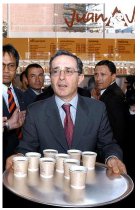 Colombia's President Alvaro Uribe is shown here serving coffee during the inauguration of a new Juan Valdez coffee shop in Bogotá, yesterday. The Colombian Coffee Federation, representing half a million coffee growers, inaugurated its flagship coffee shop with plans to open 10 others in the United States and elsewhere to compete with companies like Starbucks. The shops are a part of the federation's efforts to alleviate the suffering of coffee farmers devastated by the continuing collapse in global coffee prices, which has forced many growers to turn to cultivating of illicit crops, such as heroin or cocaine, to survive.
Colombia's President Alvaro Uribe is shown here serving coffee during the inauguration of a new Juan Valdez coffee shop in Bogotá, yesterday. The Colombian Coffee Federation, representing half a million coffee growers, inaugurated its flagship coffee shop with plans to open 10 others in the United States and elsewhere to compete with companies like Starbucks. The shops are a part of the federation's efforts to alleviate the suffering of coffee farmers devastated by the continuing collapse in global coffee prices, which has forced many growers to turn to cultivating of illicit crops, such as heroin or cocaine, to survive.
Here's an excerpt from the AP story:
-
In a bold attempt at saving small-scale coffee growers who have been hit by a collapse in coffee prices on worldwide markets, the Colombian Coffee Federation is selling its coffee and other goods at its own shops bearing the name and image of Juan Valdez, its signature character. On Wednesday, the group inaugurated its flagship coffeeshop, and plans to expand into the United States and beyond.
While prices for a latte or espresso top $2 at most of the world's trendy java retailers, coffee growers see only a few pennies of the profits, as much of it goes to middlemen or vendors. By eliminating some of the intermediaries, the federation hopes to ensure a larger part of the income for its members. The first Juan Valdez coffeeshops abroad are scheduled to open in New York and Panama by mid-2004, offering Colombian coffee in various forms, coffee beans, cakes and Juan Valdez accessories like T-shirts and bags. Ten are planned for the first phase.
Colombian President Alvaro Uribe helped open the sleek, spacious flagship shop in Bogotá’s financial district Wednesday by serving the first cups of coffee from a silver tray. It is the ninth store to open in Colombia in the past year bearing the name of Juan Valdez, the smiling, mustachioed coffee farmer sporting a straw hat and brown poncho who has appeared worldwide in numerous Colombian coffee ads.
Juan Valdez's shops in Colombia have quickly gained popularity since the first one opened at Bogotá’s international airport in December 2002, with $3.7 million dollars in coffee sales, the federation said. In trendy coffee bars in the United States, only one or two cents from the sale of each cup of coffee makes its way back to the farmers, the Colombian Coffee Federation said. The federation wants to ensure that Juan Valdez shops will generate returns of between four and five cents per cup to the farmers. Colombian coffee farmers each own a stake in the shops, whose profits are also being used to build schools, roads and hospitals in Colombia's coffee-growing region. "With this program, we are creating one of the most efficient mechanisms to transfer value from quality coffee straight to the growers," the coffee federation said in a statement.
However, Juan Valdez will likely face stiff competition abroad from the likes of Starbucks and other major coffee competitors, and the global coffee crisis shows no sign of easing. But Juan Valdez could prove popular with customers aware of the plight of coffee growers. Starbucks spokeswoman Audrey Lincoff brushed off fears of competition. "We have said always that we believe there's room for many different coffee houses," she said.
 However, all other variables being equal, I think I would probably cross the street to get my mocha-frap from a J.V. shop, versus a Starbucks... the belief alone that I'm not exploiting coffee growers or forcing them into the cocaine or heroin business, is reason enough for me.
However, all other variables being equal, I think I would probably cross the street to get my mocha-frap from a J.V. shop, versus a Starbucks... the belief alone that I'm not exploiting coffee growers or forcing them into the cocaine or heroin business, is reason enough for me.
- Arik
P.S. - So, who is Juan Valdez, anyhow? Here's a history, plus biosketch on Carlos Sánchez, who protrays J.V.:
 In 1959, the National Federation of Coffee Growers of Colombia selected the advertising agency Doyle Dane Bernbach to launch a campaign for Colombian Coffee. The agency then created the fictitious character Juan Valdez, to symbolize and personify the more than 300,000 hardworking and dedicated Colombian "cafeteros" (coffee farmers) that depend on coffee for their livelihood. In 1969, Carlos Sánchez of Medellín, Colombia, was chosen to replace José F. Duval, a New York based actor, who had until then portrayed Juan Valdez. Mr. Sánchez has been Juan ever since and is now one of the longest living fictitious characters for any advertising product. A coffee farmer himself, Carlos Sánchez was born in Fredonia, a small town which lies in the largest coffee producing region of Colombia, Antioquia. He currently resides in Medellín, where, when not portraying Juan Valdez, he makes silkscreens in his Graphic design studio and continues to maintain a small coffee farm, where many weekends are spent with his family.
In 1959, the National Federation of Coffee Growers of Colombia selected the advertising agency Doyle Dane Bernbach to launch a campaign for Colombian Coffee. The agency then created the fictitious character Juan Valdez, to symbolize and personify the more than 300,000 hardworking and dedicated Colombian "cafeteros" (coffee farmers) that depend on coffee for their livelihood. In 1969, Carlos Sánchez of Medellín, Colombia, was chosen to replace José F. Duval, a New York based actor, who had until then portrayed Juan Valdez. Mr. Sánchez has been Juan ever since and is now one of the longest living fictitious characters for any advertising product. A coffee farmer himself, Carlos Sánchez was born in Fredonia, a small town which lies in the largest coffee producing region of Colombia, Antioquia. He currently resides in Medellín, where, when not portraying Juan Valdez, he makes silkscreens in his Graphic design studio and continues to maintain a small coffee farm, where many weekends are spent with his family.
December 10, 2003
NAM Study Cites External Non-Production Costs As Primary Competitive Challenge Facing U.S. Manufacturers
The National Association of Manufacturers, or NAM, citing a new study sponsored by St. Louis-based Emerson Electric, and produced in partnership with Manufacturers Alliance/MAPI, said:
-
"External, non-production costs add approximately 22 percent to unit labor costs of U.S. manufacturers (nearly $5 per hour worked) relative to their major foreign competitors, and are the primary competitive challenge facing manufacturers and their workers," said Jerry Jasinowski, President of the National Association of Manufacturers.
"This report comprehensively documents these extra costs – corporate tax rates, employee benefits, tort litigation, regulatory compliance and energy – and estimates them at approximately 22 percent of the price of production for U.S. firms relative to our nine most important trade competitors," Jasinowski said. "These external costs are twice the size of the average direct labor costs of U.S. manufacturers, and are a major factor in our loss of trade and jobs."
"U.S. manufacturing has demonstrated the ability to overcome pure wage differentials with trading partners through innovation, capital investment and productivity," said James Berges, President of EMERSON. "But when the additional external costs described in this paper are piled on, the task becomes unmanageable, even in the best companies."
"There are many self-proclaimed friends of manufacturing expressing concern who are nowhere to be seen when these excessive non-production costs are on the table," said Jasinowski. "Taken together, external non-production costs have offset a large part of the 54 percent increase in productivity achieved since 1990. It is imperative that our elected representatives at all levels take a hard look at the costs created by their actions – and sometimes lack of action – and the impact on our economy. We simply must forge a more pro-worker, pro-manufacturing climate if our industrial leadership is to be maintained and strengthened."
Use the following link, if you'd care to read the original study, entitled How Structural Costs Imposed on U.S. Manufacturers Harm Workers and Threaten Competitiveness. It's interesting reading.
- Arik
December 09, 2003
Supermarkets, Antitrust & Union Busting: Can Anything Save Grocery Stores from Wal-Mart?

Even as major supermarket chains in California have been trying to get health care insurance concessions from labor as they desperately try to compete with the likes of Wal-Mart, California's attorney general is investigating whether three supermarket chains involved in the labor dispute with 70,000 Southern California grocery clerks have broken antitrust laws by forming a financial pact.
The three supermarket operators - Safeway Inc., Kroger Co. and Albertsons Inc. - were issued subpoenas Monday by Attorney General Bill Lockyer's office, demanding they reveal the details of a mutual-aid pact, which the companies reportedly made to share revenue so they could reduce losses in the event of a labor strike. The chains have declined to give specifics on the arrangement, which has become a factor in the weeks since the United Food and Commercial Workers' union decided to pull picket lines from Kroger's 249 Ralphs' stores on October 31st. Ralphs has seen a surge in customers ever since.
Meanwhile, talks have broken down in the grocery strike this week:
-
Labor negotiations between grocery companies and picketing Southern California grocery workers have broken off and no new talks are scheduled, officials said. About 70,000 grocery clerks went on strike or were locked out Oct. 11 at nearly 860 Ralphs, Albertsons, Vons and Pavilions stores from San Diego to San Luis Obispo. Negotiations with a federal mediator had resumed Dec. 2 between the companies and representatives of the United Food and Commercial Workers union. The talks broke off Sunday evening without a comprehensive offer put forth by the union, said Stacia Levenfeld, a spokeswoman for Albertsons.
The dispute centers on a demand by the supermarket chains that workers shoulder a larger portion of their health care insurance costs. With the strike and lockout entering its ninth week, UFCW International President Doug Dority said he is calling major UFCW local unions from the United States and Canada to a "summit" in Southern California. Union officials said they will mobilize the 1.4 million members of the union to increase strike activity.
The grocery companies in a joint statement said they "are no longer willing to absorb all costs related to maintaining health care benefits" and want to introduce a "modest level of cost sharing."
The companies also are offering a reduced wage and benefit program for workers hired on or after Oct. 6, 2003 to help them "face the enormous challenge of the changing competitive landscape." The national supermarket companies that run the chains — Albertsons Inc., Kroger Co. and Safeway Inc. — say they face pressure from Wal-Mart, Costco and other so-called big box supermarket operators who can sell goods at lower prices because they don't pay as much for their employees' health benefits.
Fact is, labor and managment are in this together. The survival of supermarkets as a business is in question when faced with the stiffness of competitive pressure from Wal-Mart and the sooner labor figures this out, the better chance they'll have a job to return to.
- Arik
December 08, 2003
Boeing vs. Airbus: Airbus Comes Out On Top

The aerospace industry has suddenly gotten really interesting. The week after Boeing's CEO Phil Condit quit the company amid the latest round of ethical misdeeds, Airbus vice president for market forecasts, Adam Brown, told reporters at the Dubai Air Show that his company had 55 percent of the market against 45 percent for Boeing, taking orders for 263 aircraft since the beginning of the year - 47 more than Boeing, crowning Airbus "the world's leading supplier" of commercial jets. Airbus, based in the French city of Toulouse, says it has sold 4,854 aircraft to 186 companies since its inception in 1970.
But Chicago-based Boeing remains unshaken. "There is no question this year they will be delivering a few more aircraft than us, but we are not concerned about one downturn year," Boeing's marketing vice president, Randy Baseler, told The Associated Press:
-
Promoting the A380, marketed as the world's largest passenger aircraft, Airbus said Monday its new carrier is the future of airline growth. The 555-seat plane, designed to fly nonstop for long hours, is scheduled for its first flight in 2005, with deliveries set to begin in early 2006. There have been 129 orders for the craft from 11 countries, including Dubai-based Emirates airline and Doha-based Qatar Airways. "Based on our experience we see nothing on the horizon which can cost-effectively supersede the aircraft we offer today," Brown said.
In its separate news conference, Boeing expressed skepticism about Airbus' market forecasts, saying airlines usually handle growth in air travel by increasing frequencies and nonstop flights, not plane sizes. Boeing also says the A380's size would require airport adjustments and changes in the way airlines do business. Baseler said the future is for smaller jets. "On the global scale, we see market fragmentation — or 'point-to-point' operations_ continuing, which means airlines will rely more and more on smaller airplanes," he said. Baseler said this is why Boeing believes the future of its 250-seat 7E7 Dreamliner, which is planned for 2008, is promising. Brown said Boeing seems to be "in a parallel universe," adding that the A380 has had "the biggest market response to any jet" in numbers of orders.
Meanwhile, I found another biting commentary on Slate.com about the Boeing's recent slide, "Jet Lag: How Boeing Blew It"... here's an excerpt:
-
...as Boeing managers tried to fit McDonnell Douglas into the corporate mix, Airbus took off. One story has it that an Airbus executive boasted in 1997 that his company's sales would easily surpass Boeing's by 2003. Phil Condit, attending the same meeting, laughed. Now Airbus holds a huge lead over Boeing in orders; in 2002 and 2003, Airbus commanded nearly 60 percent of the global market—precisely the dominant share that Boeing enjoyed back when Condit was so amused.
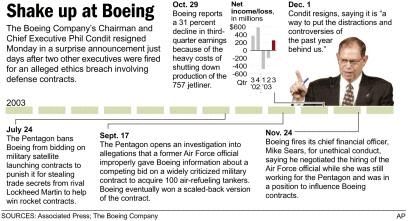
Boeing's plummet matters in a big way, and not just for Boeing. The company has long been a major exporter: A single order of 747s (most of which sell for around $200 million) is capable of putting a sizable dent in the U.S. trade deficit, which likely will surpass $500 billion for 2003. Those fat orders now are essentially gone. Sales of 747s have screeched to a halt since Airbus announced plans to build the 550-passenger A380, due to fly in early 2005.
The sight of a European or Asian airport packed with 747s and 777s says one thing about the United States. Those same airports crammed with Airbus A340s—and, before long, with mammoth A380 superjumbo jets—say another. Boeing's diminished clout in commercial aviation is also bad news for the U.S. airline industry, which may soon find itself with only one viable source of aircraft: Airbus. Goodbye to all the sweet deals the airlines extracted from Boeing or Airbus when the two were fiercely competing.
To save itself, Boeing needs to accomplish two feats. One is to mend fences with the Pentagon and save the deal under which it will build 100 767 jets to serve as midair tankers (the only hope for the aircraft, which no commercial customer now wants). That may not be terribly hard; the Air Force really, truly wants those tankers, and even John McCain's blustering over the deal isn't likely to impede it.
But the other more important challenge for Boeing is to get back to basics in commercial aviation, which after all is what built the company during the 1960s and 1970s. Whether Boeing is up to the task is far from clear. After fiddling in recent years with notions for a supersized 747 and a fast jet called the "sonic cruiser," Boeing has decided its savior will be a jet called the 7E7 "Dreamliner." This twin-engine, 220-seat jet is supposed to give airlines a comfortable, superefficient plane that dovetails nicely with the move away from hub-and-spoke airline flight patterns and toward the point-to-point flights preferred by customers.
Ironically, says Paul Czysz, a professor emeritus of aeronautics at St. Louis University, that might have been found in the McDonnell Douglas archives. During the 1980s and 1990s, engineers there developed what is called the "blended wing"—a variation on the flying-wing model used in the B-2 bomber. Basically, a blended wing is simply a fat wing with the engines and tail fins attached to it—no long skinny tube with the wings stuck on the side. It's an ideal design for commercial aircraft—even more fuel efficient than the proposed 7E7, capable of carrying huge loads, easily switched between passengers and cargo and back. Should any U.S. aviation company actually build a commercial version, says Czysz (full disclosure: He's a former McDonnell Douglas guy), no other airliner could compete. Boeing toyed with something a little like the blended wing with its proposed sonic cruiser, but scrapped that in the wake of Sept. 11 and the collapse of commercial aviation.
The 7E7, offered in its place, is certainly a safer bet. But if the Dreamliner isn't a winner—and there is no clear evidence that it will offer airlines something that Airbus can't—the odds are good that Boeing will be out of the commercial aircraft business in 10 years. To leapfrog Airbus, Boeing needed to roll the dice. Instead, its new culture of soaking the taxpayers for military goodies while playing it safe on the commercial-aircraft front may have cost Boeing its future and blown a hole in the U.S. economy that never will close.
Undoubtedly, without the competition between Boeing and Airbus over the past 30 years, the flying public as well as our militaries would be worse off, so I sincerely hope Boeing can start getting its act together... for the good of its shareholders, the U.S. economy and that of global aviation.
- Arik
UPDATE: On Wednesday 10 December, AP reported from Paris that Airbus said it has been gathering information on public aid to Boeing to check whether Washington has breached an agreement with Brussels, and is particularly concerned about pledges of U.S. government support for its U.S. rival's planned new fuel-efficient passenger jet, the 7E7 "Dreamliner."
-
"We're following very closely what's happening with the 7E7 and forwarding the information we are gathering to the EU authorities," Airbus spokesman David Voskuhl said. He was speaking after French daily Le Figaro on Wednesday quoted Airbus CEO Noel Forgeard voicing concern over Boeing funding. "We want European Union countries to know what's going on," Forgeard was quoted as saying.
Under the terms of a 1992 bilateral accord on civil aviation, the United States and the European Union pledged that government loans would not be allowed to exceed 33 percent of total investment by their respective aerospace companies. Since then, however, both sides have repeatedly accused each other of breaking the deal.
Airbus is concerned about government loans and subsidies promised to the Japanese companies lined up for about one third of the manufacturing work for the 7E7. These include Japanese engineering firms Mitsubishi, Kawasaki and Fuji.
Boeing spokesman Todd Blecher said he found it "ironic" that Airbus was raising concerns about potential support for the 7E7, given "the billions of dollars in subsidies Airbus has received for more than 30 years."
"It's premature for anyone anywhere to speculate on the specific funding mechanism our partners might use for the 7E7," Blecher said.
ANOTHER UPDATE: On Tuesday 16 December, Boeing announced it would begin booking orders for the new 7E7 Dreamliner.
-
"This is a capital-intensive business and this aircraft is a gamble, but it's a smart gamble," said John Murray, an analyst who covers Boeing for Delaware Investments, which owns Boeing shares. "If they didn't do it, Airbus would be standing alone in this business in 40 years."
Without the 7E7, analysts say Boeing would be relegated to also-ran status in the two-horse race with Airbus, which has become the world's most prolific jetliner maker with a backlog of 1,467 jet orders compared with Boeing's 1,112.
Airbus officials have called the 7E7's improvements over Boeing's current jets minor, saying price discounts on the competing A330-200 could eliminate any advantage the 7E7 might bring for airlines.
"When Airbus says they are going to offer discounts, they are already admitting theirs is an inferior product," said Randy Baseler, vice president for marketing at Boeing's commercial jet unit.
Airbus Chief Commercial Officer John Leahy said the A330-200 would beat the 7E7 and win at least half the 1,800 jet orders he expects for mid-sized jets over the next 20 years, expressing surprise that Boeing would spend so much money just to match the A330.
"If the question is: If they bring out the 7E7 what are we going to do, the answer is nothing. We are very content to stay with our A330-200," Leahy told Reuters.
The 7E7 would replace the slow-selling 757, which Boeing is discontinuing, and the 767 line, which has slowed to just one aircraft per month to sustain production until a controversial order for 100 U.S. Air Force fuel tankers is finalized.
The company had considered about 20 locations for a 7E7 assembly plant, eliciting a wide range of offers to cut taxes and build new roads and facilities, including a $3.2 billion aerospace industry package from the state of Washington.
The 7E7 will create just 800 to 1,200 Boeing jobs in Washington, but thousands more will go to local suppliers and state officials were determined to keep the jet business at home after Boeing moved its headquarters to Chicago in 2001.
"It would be more devastating to our economy and our government coffers if Boeing did not build the 7E7 in our state," Washington Gov. Gary Locke told Reuters by telephone. "We would have seen the gradual relocation of Boeing commercial activities to another state, and the loss of 130,000 direct and indirect jobs."
December 07, 2003
Sun's Java Desktop System (JDS) Going After Microsoft Windows & Office
 Sun Microsystems seems to be coming on strong of late, especially targeting Microsoft Windows/Office dominance with its Java Desktop System, based on Linux, StarOffice, Mozilla and GNOME. With recent wins at Wal-Mart and with the government of China, it looks like the desktop might get interesting again. I'll spare the excerpts, but here are a few links:
Sun Microsystems seems to be coming on strong of late, especially targeting Microsoft Windows/Office dominance with its Java Desktop System, based on Linux, StarOffice, Mozilla and GNOME. With recent wins at Wal-Mart and with the government of China, it looks like the desktop might get interesting again. I'll spare the excerpts, but here are a few links:
- Sun's JDS Rivals Windows, Office
- What's Behind Microsoft's Office Moves?
- Sun's Scheme for Desktop Domination
- Sun Shines on China
- Sun Pushes Harder on Everybody's Buttons
- And, a full compilation of articles on the subject by eWEEK
Now, this sounds familiar... Java and Mozilla, at least - didn't Netscape try this back in '96? Whether this could be Sun's strategy for tomorrow is less certain, but we are sure to see price commoditization if things catch on, and they've got the CFO's ear now with a pricing model that beats the pants off Microsoft's. Let's hope they don't screw it up - we'll all be better off if competition can be restored to the desktop software universe.
- Arik
December 06, 2003
Sneaker Wars: Nike & Adidas Toe-to-Toe
 I found a great article in the Oregonian that captured the level of competitive rivalry going on between Adidas and Beaverton-based Nike:
I found a great article in the Oregonian that captured the level of competitive rivalry going on between Adidas and Beaverton-based Nike:
-
The hundreds of Adidas-Salomon sales reps meeting to celebrate the company's new Switzerland office grew silent as executive Michael Rupp began venting. For half an hour, Rupp, in charge of the sneaker company's central European business, assailed their complacency. If things don't change, Adidas might become an also-ran, Rupp says he told the gathering.
Shoppers still buy more Adidas gear in Europe than any other brand, but Nike is narrowing the gap, even selling more sneakers. And it's gaining in Germany, Adidas' home country and the world's third largest economy.
"We have to fight for our future," Rupp says he told his crew in June. It's time to launch into "forward-oriented attack mode." The sneaker wars are escalating across Europe.
Beaverton-based Nike, the biggest company with headquarters in Oregon and the state's lone Fortune 500 firm, sees Europe as its next conquest, having defeated Adidas in the United States. Adidas, whose U.S. operations are based in Portland, has heeded the battle cry.
The industry's two biggest titans face enormous pressure to capture Europe. Their shareholders continue to demand profit, sales and stock-price gains. But in recent years, Nike and Adidas have found diminishing returns in a mature U.S. market, the world's largest for athletic shoes and clothing. Nike did more business outside the United States for the first time in its last fiscal year. And after several years of stagnation, Adidas expects its U.S. sales to fall this year.
Here's another excerpt:
-
Research shows that Nike needs to downplay its status as a big American brand to stem backlash that accelerated with this year's war in Iraq, unpopular in much of Europe. On the other hand, Adidas must attract a generation of consumers who, unlike their parents, weren't raised on a sneaker diet limited to German brands.
Adidas' challenges Through much of the mid-20th century, Adidas owned Europe. Hometown rival Puma -- like Adidas, based in the northern Bavarian village of Herzogenaurach, Germany - was its biggest threat for decades.
Nike changed everything.
At first, Adidas shrugged off Nike's 1968 birth. But then it watched with increasing alarm as Nike grew into a powerhouse that sold about as many sneakers in the United States as Adidas, Reebok and New Balance combined.
Marketing itself as an unconventional American alternative, Nike entered Europe about two decades ago. By 1998, it had elbowed out Adidas as the No. 1 sneaker seller. And since then, Nike has narrowed Adidas' edge in overall sales, which count clothing and equipment. Today, Adidas realizes it's dangerous to rely on tradition, habit and brand loyalty.
Resentment from the U.S.-led war in Iraq and a wave of corporate scandals have begun to undermine American brands abroad, especially well-known ones such as Nike, according to a study released in July by RoperASW. As a result, the firm found, the percentage of Germans who regularly use or own a Nike product dropped to 29 percent this year from 49 percent in 2002. The percentage fell to 38 percent in France, down from 45 percent.
Indeed, Nike's European sales have flagged over its last three fiscal quarters, compared with year-earlier periods, currency exchange-rate fluctuations aside.
Nike officials, however, dispute the Roper findings and deny that anti-U.S. sentiment has cut sales. They point to a 21 percent rise in European orders for delivery by January -- again, without accounting for currency changes.
And, finally:
-
To secure future growth, the company is revamping its methods. Rupp told his sales force in September to spend more "quality time" with Adidas' 1,000 largest retail clients. The move will cut face time with smaller customers by almost a third, but Rupp says they won't be ignored. By the end of the year, they will be able to place orders faster using automated machines. The changes will result in a few layoffs, Rupp says.
Adidas also has stepped up its "Winning in Europe" campaign, a 2000 initiative to establish Adidas as the clear European leader by 2006. A headline on a recent 20-page campaign newsletter reads: "Watch out competition -- Adidas is back to take the lead in Europe." Stories highlight successes, such as Italy, and problem areas, such as the Nordic nations, where "there is a growing sense of urgency," according to the newsletter. "Sales have been declining since 1998, weakening our position and threatening our clear market leadership."
One new tactic involves reducing the array of Adidas products by 30 percent by 2006. The company believes that fewer models will lead to lower product-management costs, higher profits and more time to refine forecasts. Already this year, Adidas has eliminated walking shoes and reduced its tennis shoe assortment from 19 to 14 models. "It's a full onslaught battle to grow the brand -- any way, shape or form," says Glenn Bennett, Adidas-Salomon's executive board member in charge of global operations.
It seems Adidas gets the competitive threat Nike represents on its home turf; too bad it's too late to save some of its markets abroad and the "full onslaught battle" had to be such a defensive one.
- Arik
p.s. - It seems the year-old unrest between Foot Locker and Nike has finally been put to bed, thanks to an 18-year-old basketball superstar, LeBron James, who secured his endorsement with $90 million bucks. That, and the retro-style trend that Nike will deliver on exclusively for its biggest buyer, in the form of "20 Pack"... your guess is as good as mine.
December 05, 2003
Bush Lifts Tariffs on Steel & Averts a Trade War

President Bush announced that he finally succumbed to his advisors' counsel and lifted the 21-month-old steep tariffs on imported steel that had riled trading partners in both Europe and Asia. Here's an excerpt from the Washington Post:
-
The action, although expected, marked a rare about-face for an administration not noted for reversing course. And it brought angry reactions from labor unions and executives in the steel-producing states of West Virginia, Ohio and Pennsylvania, all of which were closely contested in the 2000 presidential election and are expected to be battlefields in 2004.
The tariffs, which were as high as 30 percent when imposed 21 months ago, were lifted at midnight, 15 months before their scheduled expiration. Bush said the tariffs had done their job, stemming a flood of cheap steel imports long enough to allow U.S. producers to consolidate and get back on their feet.
In a written statement read by his press secretary, the president also noted that economic circumstances have changed markedly since the tariffs were imposed. Surging demand for steel has boosted prices, and a weakening dollar has made U.S. steel exports more competitive in the global market, administration officials said.
"I took action to give the industry a chance to adjust to the surge in foreign imports and to give relief to the workers and communities that depend on steel for their jobs and livelihoods," Bush said. "These safeguard measures have now achieved their purpose, and as a result of changed economic circumstances it is time to lift them."
Administration officials had signaled that the tariffs would be lifted as far back as mid-September. Bush's economic team had united in a push to lift them, arguing that they had cost more jobs among steel users than they had saved among steel producers. Even Bush's political advisers, who had been instrumental in imposing the tariffs last year, had concluded that they may have backfired politically. Then in November, the World Trade Organization ruled the tariffs illegal, allowing other countries to prepare to impose retaliatory tariffs this month.
Shortly after the White House announcement, the European Union withdrew its threat to impose tariffs on about $2 billion of U.S. exports.
The Commerce Department will closely monitor steel shipments into the United States and continue licensing imports, so the administration can react if there is a surge of cheap imports, Bush said. The president, however, offered no additional aid to the industry or its workers.
That elicited a sharp response from steel producers, which had hoped for more assistance or a phaseout of the tariffs rather than an immediate lifting. Publicly, steel officials were muted in their criticism. Thomas J. Usher, the chairman and chief executive of U.S. Steel Corp., who had just hosted Bush at a campaign fund-raiser earlier this week, said he was "delighted" to hear that the Commerce Department will "aggressively monitor" steel prices. In public comments, other steel executives were similarly understanding.
The New York Times, notes moves of the World Trade Organization and the European Union, which determined that the best way to beat back the tariffs would be to go after American exports from states deemed more crucial to Bush's re-election efforts, such as Florida citrus and Michigan's automobiles. "For the first time in his nearly three years in office, the president, who has often reveled in the exercise of American power, finally met an international organization that had figured out how to hit back at the administration where it would hurt," the Times notes.
Still, organized labor thinks the decision stinks:
-
Leo W. Gerard, president of United Steelworkers of America, vowed to make Bush pay a political price for his "betrayal of American steel workers and steel communities."
"We're not going to give up," he said. "We're going to fight like hell for justice."
Mark Glyptis, president of the Independent Steelworkers Union, vowed that his union "will now work very hard to make sure George W. Bush joins the ranks of the unemployed next year."
"What we've now told the world today is, 'You're welcome to come abuse us, to come and abuse our trade law,' " Gerard said, because "we're going to cave in when you threaten to retaliate."
U.S. Trade Representative Robert B. Zoellick said yesterday that the decision was made independently of the threats of retaliatory tariffs.
And, lifting tariffs here have made it more confusing to interpret the administration's trade policy:
-
Just last month, the administration slapped import quotas on some Chinese textile imports, in what is widely seen as a first installment of actions against Chinese apparel, and this month, it is expected to take action against imports of Chinese bedroom furniture.
Zoellick portrayed the tariff decision in different terms. In the past 18 months, he said, the federal government had assumed $8.2 billion in pension benefits from 14 bankrupt steel companies. U.S. steel exports in August were 49 percent higher than they were a year earlier, and Bush had proven that he is willing "to help people that are knocked off their feet."
"You've got about 150,000 steel workers in this country, and they can thank this president for having a chance to compete in the future," he said.
Steelworkers responded with their own statistics: 225,000 steelworkers with lost health benefits, thousands more who have lost all or part of their pensions, the federal Pension Benefit Guaranty Corporation teetering under the weight of its new steelworker benefit responsibilities, and companies still on the edge of viability.
- Arik
December 04, 2003
For FAO Schwarz, Christmas Looks Like A Humbug
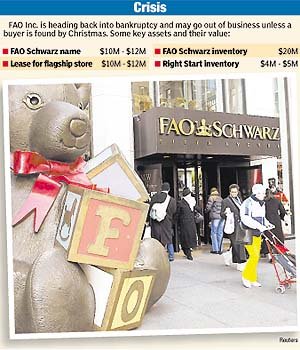 Venerable retailer FAO appears poised for liquidation, even as the toy-shopping season approaches for Fifth Avenue's FAO Schwarz.
Venerable retailer FAO appears poised for liquidation, even as the toy-shopping season approaches for Fifth Avenue's FAO Schwarz.
Zany Brainy is already being liquidated and FAO Schwarz and The Right Start are right-around-the-corner, if a buy-out can't be arranged before December 15th. Here's an excerpt:
-
...hefty competition, especially from discounters willing to slash prices, was too much for FAO. The company said in November it had instructed a banker to find a buyer for the business.
One likely suitor is Saks Inc., which invested $5 million in FAO and operates boutiques under the FAO name in some of its department stores, a person familiar with the situation said.
Another possible bidder could be Target, which has made a reputation of acquiring well-known brands like Isaac Mizrahi, this person said.
Julia Bentley, a Saks spokeswoman, didn't return a phone call seeking comment. A Target spokesman couldn't be reached.
FAO is racing the clock, given that the value of its inventory quickly loses value after the Christmas season.
As a result, the company said if a deal is not completed by Dec. 15 it could be forced to quickly sell the remaining assets of FAO Schwarz and The Right Start, including inventory, trademarks and leases.
That scenario would open the door to a wider range of buyers, including private equity firms and toy manufacturers interested in licensing the FAO Schwarz name, but not in running retail stores, analysts said.
The main assets for the 15-store FAO Schwarz chain include rights to the name, controlled by the FAO Schwarz Family Foundation, with an estimated value of $10 million to $12 million; the lease to the flagship Fifth Avenue store ($10 million to $12 million); and the inventory ($20 million). All told, the company could be worth $45 million to $55 million, analysts said.
- Arik
December 03, 2003
Rival Tortilla Makers Sue Over Supermarket Shelf Slotting
 In search of a story today, I found out about this Tortilla flap in Harris County (Texas) District Court with a bunch of small, independent tortilla entrepreneurs are going up against a dominant competitor from Mexico to try and keep them from putting them all out of business by giving kick-backs to supermarkets.
In search of a story today, I found out about this Tortilla flap in Harris County (Texas) District Court with a bunch of small, independent tortilla entrepreneurs are going up against a dominant competitor from Mexico to try and keep them from putting them all out of business by giving kick-backs to supermarkets.
From the Houston Business Journal:
-
The outcome of a current court battle between rival tortilla makers could affect the way product space is allotted on supermarket shelves. The trial began late last month over an antitrust lawsuit filed in Harris County District Court in July of 2001 by a group of 18 tortilla makers, including three in Houston.
The suit claims Dallas-Based Gruma Corp., a subsidiary of Mexican conglomerate Gruma S.A. de C.V., conspired to monopolize the sale of tortillas in various markets by using its dominant size to extract concessions from retailers. The group of small, independent tortilla producers seeks $70 million in damages. The case is significant on several fronts, legal sources say. A final verdict either way would set a strong precedent for future antitrust litigation.
Another primary focus, especially among attorneys, is the potential affect on "slotting fees," payments made by producers to retailers for the purpose of gaining preferential exposure for products ranging from toothpaste and tortillas to soft drinks and detergent. The financial stakes are also high. The $5 billion tortilla industry serves one of the fastest-growing food products in the country.
Rick Davolina of Davolina and Eureste LLP, one of several firms representing the tortilla makers, says the entrepreneurs took legal action to protect their interests. "We think it's a very significant case because the clients are all small business people who have been in the tortilla business for a long time," says Davolina. "Most of them are family-owned and have managed to grow their business."
Also representing the tortilla makers is Thomas Stanley of local firm Eastham Watson Dale & Forney LLP, who recently won a $14 million judgment against The Coca-Cola Co. on behalf of five independent soft-drink bottlers in a similar case over anti-competitive practices.
According to the lawsuit, the defendants:
1.) Controlled or tried to control the economic viability of competitors through financial payments to retailers.
2.) Unfairly used the company's buying power to influence where products landed on store shelves and, by extension, illegally controlled the fate and competitiveness of other products.
3.) As a result, the suit claims, Gruma and its associated companies "have eliminated or substantially reduced the availability and visibility of competing tortilla products ..."
Such restrictions allegedly have shut the smaller rivals out of a lucrative market. Tortillas have become big business in recent years. Nearly a third of the U.S. bread market belongs to tortillas, according to claims by the Dallas-based Tortilla Industry Association. The organization's membership includes more than 175 tortilla manufacturers, industry suppliers, distributors and companies with interests in the tortilla industry from around the world.
Antitrust attorney David Donaldson of Austin-based George & Donaldson LLP says the impact on future antitrust litigation will depend on how far the case is taken. If there is a high-dollar judgment favoring the independent tortilla makers that is then sent to the Texas Court of Appeals, it could set a precedent for how lawyers around the state argue on behalf of clients. "Our system recognizes that a company can get as big as it can get as long as it operates legitimately," says Donaldson.
- Arik
December 02, 2003
Subway Chooses Coke over Pepsi
 Coke will become the exclusive supplier of fountain drinks to Subway Restaurants, putting an end to the chain's partnership with the Pepsi unit of PepsiCo, The New York Times said on November 27th:
Coke will become the exclusive supplier of fountain drinks to Subway Restaurants, putting an end to the chain's partnership with the Pepsi unit of PepsiCo, The New York Times said on November 27th:
-
The deal, effective in 2005, will put Coke fountain drinks in Subway's 20,000 restaurants around the world, according to the Times. Pepsi had been the primary provider of fountain drinks served in the chain since 1988, although Coca-Cola supplied about 15 percent of the restaurants with fountain drinks, bottles and cans, the paper said.
Officials at Subway said they began evaluating the company's beverage business about a year ago and decided a single beverage distributor would best meet its needs, the report said. The officials said they chose Coke because they felt that it would help Subway with marketing, innovation and global distribution, according to the article.
- Arik
December 01, 2003
Handspring's Treo 600: A Hot Product with a Big Flaw
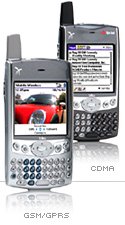 Pretty, aren't they?
Pretty, aren't they?
With Christmas coming up, I thought I'd highlight one of the gadgets that's sure to be on a bunch of wish-lists this season: Handspring-ne-PalmOne's Treo 600. Sporting a VGA digital camera, quad-band GSM or CDMA models, QWERTY thumb-board, SDIO expansion and a Palm 5 OS, this is the coolest entry in the smart-phone category.
Unfortunately, it'll sell like hotcakes - despite what I believe is perhaps the silliest product oversight in mobile communications. This thing has no removeable battery! Not only do cell-phones run out of charge, PDA's make power demands even more robust, and now I can't even carry a spare around to bail me out in a jam.
Furthermore, batteries eventually wear out and won't take a charge any longer. If I'm gonna shell out $600 bucks for a Treo 600 (that must be how they price 'em, eh?) at least let me amortize that investment over a few years of product life. I don't think PDA-makers can afford (yet) to build in planned obsolecence like that.
Although I know I'm not the only one who feels this way, it's a shame this product will sell so well - it's falsely reinforcing to the manufacturer that the issue doesn't matter. This had been my must-have gadget of the season, but until it comes with a replaceable battery, it's off my list for good.
- Arik
 "Competitive Intelligence applies the principles of competition and lessons of intelligence to the need for enterprise awareness and predictability of market risk and opportunity. CI has the power to transform an enterprise from also-ran into real winners with agility enough to create and maintain sustainable competitive advantage."
"Competitive Intelligence applies the principles of competition and lessons of intelligence to the need for enterprise awareness and predictability of market risk and opportunity. CI has the power to transform an enterprise from also-ran into real winners with agility enough to create and maintain sustainable competitive advantage."
